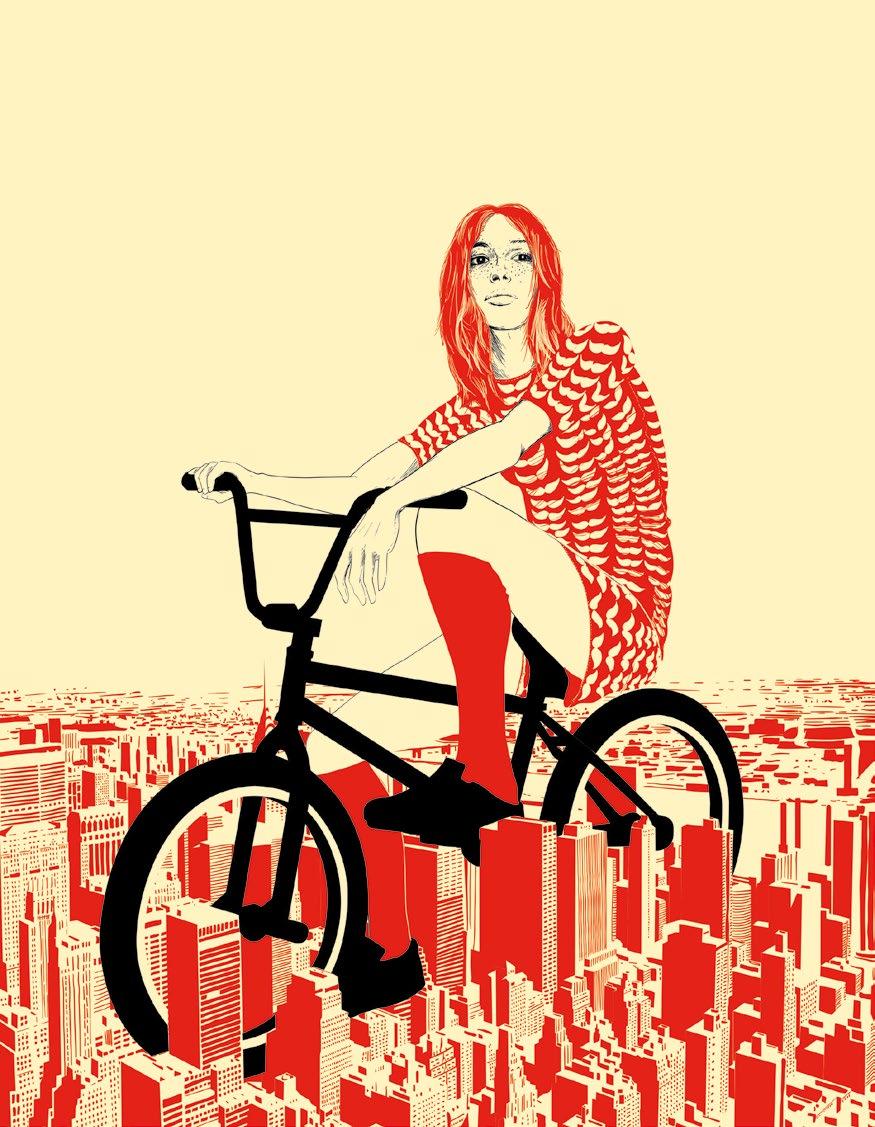
issue #15

Boneshaker: Real Cycling
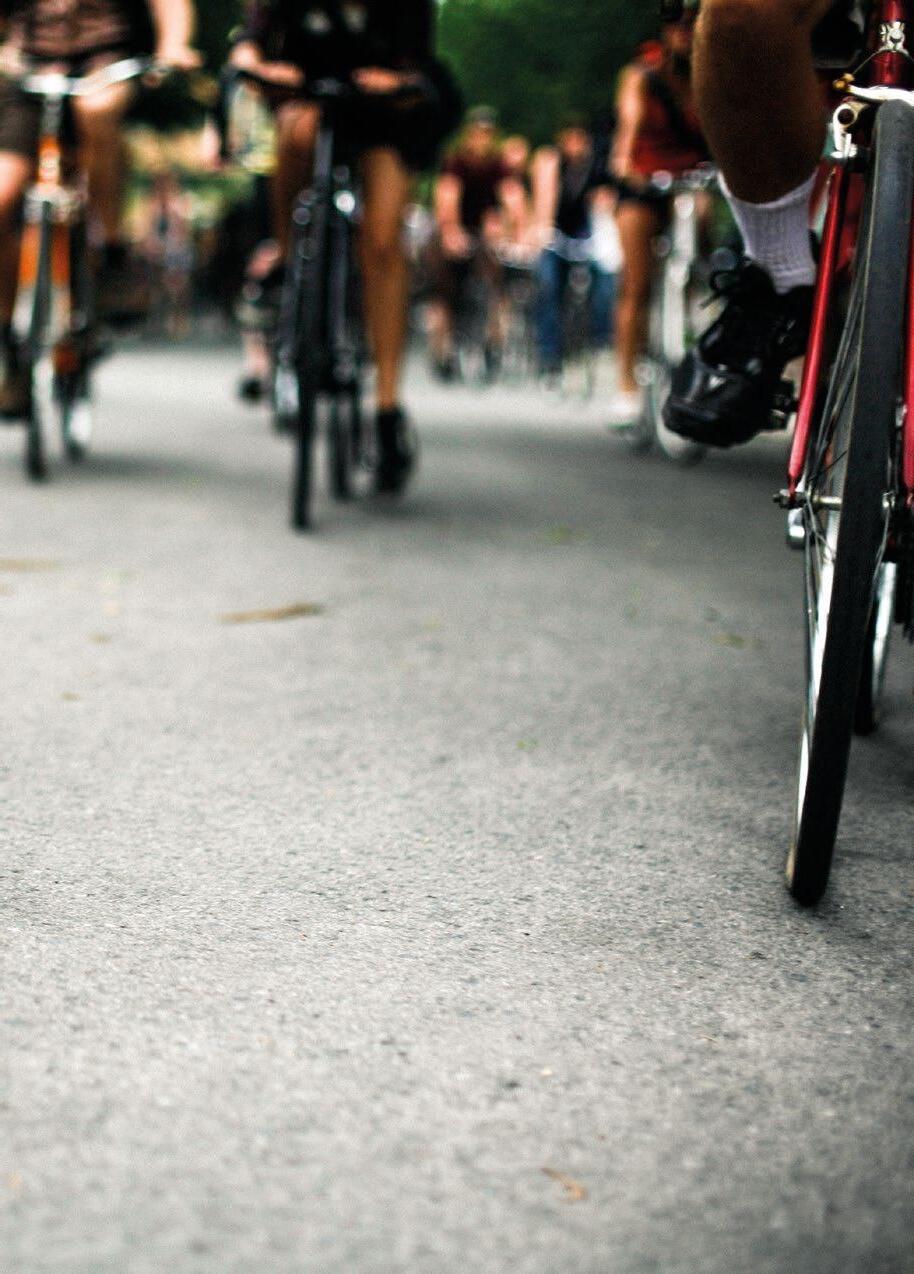
Except this isn’t real, of course, it’s digital. To get your hands on a real Boneshaker, to feel it and smell it and hide it in your pannier, go here. We make other great bike stuff too, especially bicycle art prints. Check them out here. And to let your ears take your mind on a journey, there’s our new podcast series.
For kicks. For adventure. For the soul.
The reasons we ride are as varied as the places we ride through. Thousands of miles are covered in the next hundred pages: our brave writers journey underground and back in time, through America, across the Balkans, over the Alps and the Himalayas and on around the world. Twice. But for all these vast distances, the greatest journey they each make is in the mind, as the wheels spin, the heart expands and the self unwinds to a distant horizon...
Welcome to issue #15
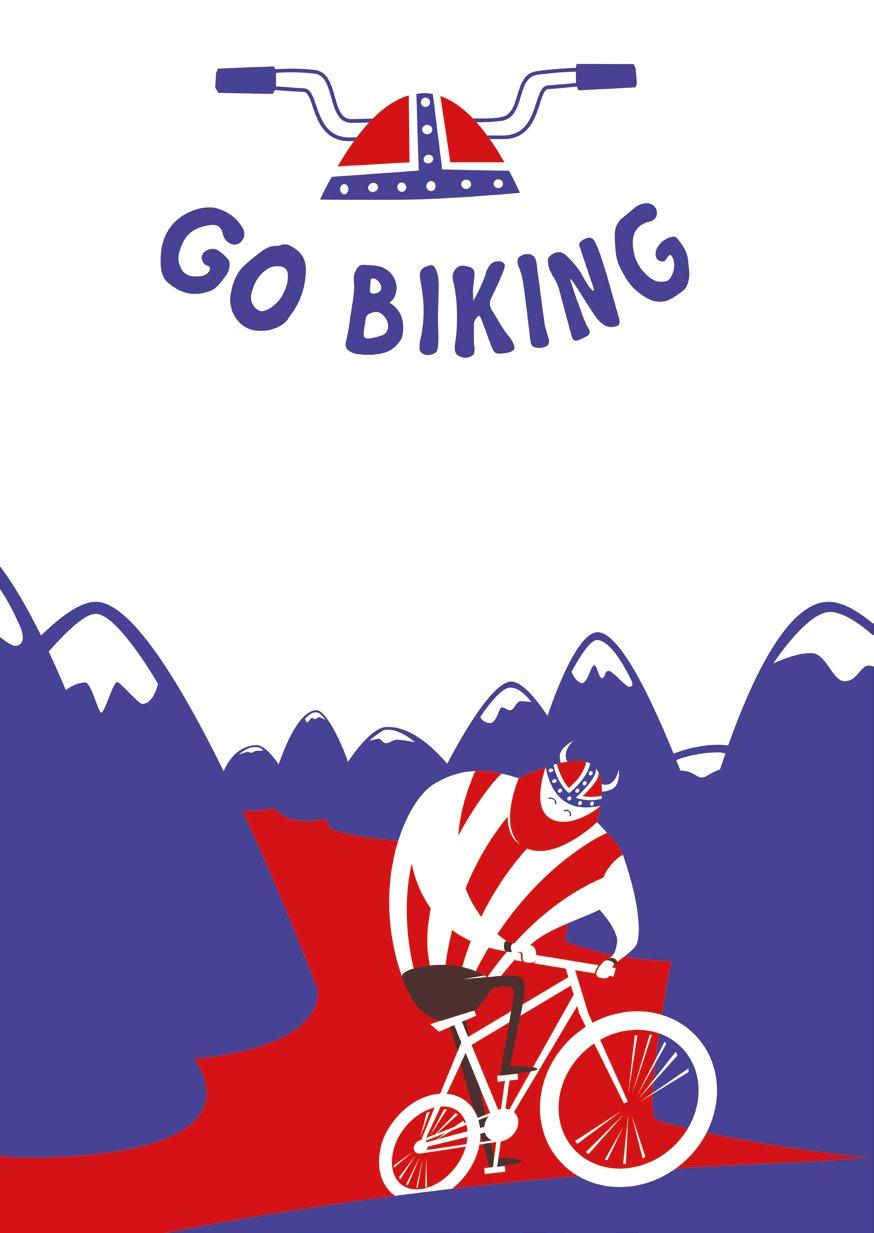
contributors
words marko S ˆajn, jude brosnan, julian sayarer, zoe howes-wiles, marc simper-allen, mike white, matt cook, dave gill, raphael krome, alex throssell, simon lay, scribbletribe studios, chris lanaway, tony haupt, jet mcdonald, pi manson
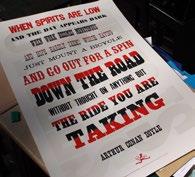

photographs marko S ˆajn, ty snaden, colin flash tonks, joff summerfield, lucas brunelle, benny zenga, duncan elliott, chris sleath, dave gill, raphael krome, simon lay, chris lanaway, tony haupt
illustrations ... paul heredia, re-robot studio, chris sleath, casmic lab, gill chantler, samuel james hunt, chris thornley, eleanor shakespeare
layouts joanna buczek, luke francis, chris woodward, max randall, jordan carr, molly cockroft, jack sadler, sam edwards, ben hamilton, katie mitchell, ali campbell
backpats and handclaps
john coe, matt at bristol dropouts, peter whitehead, the bristolian café’s mega breakfasts, kai at offscreen, rob, ryan & the roll for the soul crew, benjy johnstone, james perrott for his unwavering business guruship, tor mcintosh, benny zenga, nick hand at the letterpress collective, rik at ripe digital, matt farah at williams research center, tommy godwin, anny mortada, penny morris, muriel at swrve, our fellow bipsters, oliver norcott, phil hambley at scribbletribe studios, sadie ruth campbell, cass gilbert, suresh ariaratnam, and the unflappable support of ian and the crew at taylor brothers. no thanks at all to betsy the keyboard-trampling cat
copyrights & disclaimers
The articles published reflect the opinions of their respective authors and are not necessarily those of the publishers and editorial team. © 2014 Boneshaker. At present, we are committed to remaining free from advertisements & advertorial.


contents
Printed in Bristol by Taylor Brothers (taylorbros.uk.com) on FSC ® certified paper. Boneshaker is extremely proud to be part of Bristol Independent Publishers (wearebip.co.uk) conceived by james lucas & john coe / compiled, edited and brought to life by jimmy ell & mike white / lead designers luke francis ( talktofrancis.com ) & chris woodward (chriswoodwarddesign.co.uk) / cover image by chris thornley (raid71.com) / opening illustration (opposite) by re-robot studio (re-robot.com)
tommy godwin, the long distance legend 4 the ups & downs of a year-long bicycle tour 8 bikes & beetles 16 electric pedals 18 life cycles 22 that pipe! 28 in for a penny 36 a space the eye cannot see 42 the papergirl 48 dream maker 52 artbreak 56 press on 58 the classics experience 64 the old and the new 70 the transalp 76 balkan ride 80 steel yourself 86 the first trip 92
Tommy Godwin’s record-breaking 1939 ride is a feat of physical and mental endurance so momentous, so outrageous, that it’s difficult to fully comprehend what the achievement actually represents.
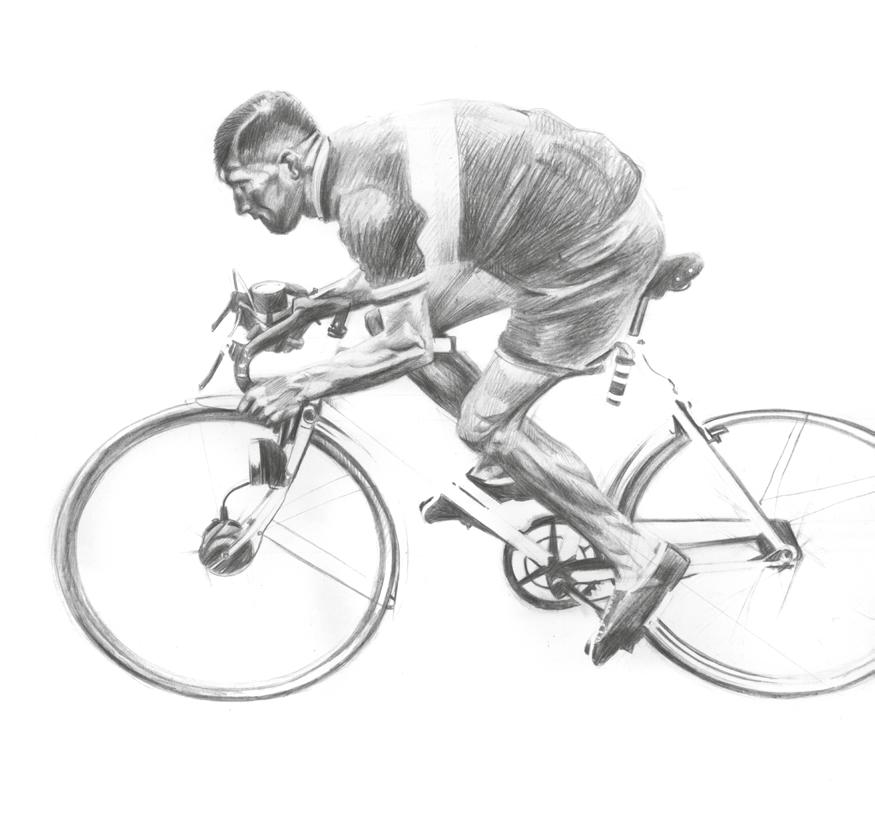 Illustrations by Samuel James Hunt
Illustrations by Samuel James Hunt
TOMMY GODWIN THE LONG DISTANCE LEGEND
Perhaps the greatest endurance feat of all time, and one of the least well-known and celebrated, Tommy Godwin’s record-breaking 1939 ride is a feat of physical and mental endurance so momentous, so outrageous, that it’s difficult to fully comprehend what the achievement actually represents.
If you are not a regular cyclist, but particularly if you are, consider this scenario: you wake before the dawn and drag yourself from your bed and out into the bleak morning of a Boxing Day in wartime England.
You eat little (if anything) for breakfast and ride purposefully through the inclement weather and along poorly maintained streets. Your bike is wellmaintained, but is a heavy steel-framed machine with only four gears. You ride for some hours, and then you ride for many more – until you have completed a shattering 185 miles on the road.
The next day you ride 204 miles.
You don’t think that this is particularly extraordinary; in fact it’s actually a little below your daily average, and after all you have been doing this for over fifty-one weeks straight, with only one day off!
In four days’ time you have good reason to cheer the arrival of the New Year – your name is Tommy Godwin – and you have just smashed the record for most miles cycled in a year.
In a modern age of millionaire golfers and petulant footballers, Tommy’s achievement serves as a
useful reminder of what true sporting prowess was, and can still be. Tommy was described by his family as the most unassuming, gentle man, but he quietly proved that he was as hard as iron physically.
Known to friends and family simply as ‘Tommy’, Thomas Edward Godwin was born in Fenton, Stoke-on-Trent on the 5th of June 1912. At the time children grew up quickly, were often raised in hardship and were expected to work from an early age. Tommy was no exception, and took a job as a delivery boy aged twelve, which helped him to pull his weight and share the burden of providing for a family of twelve.
A requisite (and most likely to young Tommy a perk) of the job, Tommy was equipped with a heavy bike with which to complete his daily deliveries on behalf of the owner of a general store, newsagents and butchers. Tommy enjoyed riding the bike as part of his rounds, and an interest in cycling sparked to life.
A few years later, the then fourteen-year-old Tommy would be inspired by an advert asking for participants in a local 25-mile time trial.
Legend has it that Tommy hacked off the heavy steel delivery basket from the front of his bike, and kitted out with both borrowed shoes and wheels proceeded to steam around the course in a winning time of one hour and five minutes.
Still at a tender age, the initial spark had already exploded into a full blown love affair with cycling.
7
He joined various cycling clubs, won races, and began to amass an array of over 200 medals and trophies, and by 1937 his confidence was such that he decided to challenge the ‘year record’, a record recently won by the Australian pro-rider Oserick ‘Ossie’ Nicholson.
Tommy succeeded in persuading his employer to sponsor him, and at 5am on New Year’s Day 1939, after months of physical and mental preparation, vegetarian, tee-totalling, 26-year-old Tommy pushed off, and pedalled the first mile of a journey that ultimately would not end until a further 500 days, and 99,999 miles had been completed.
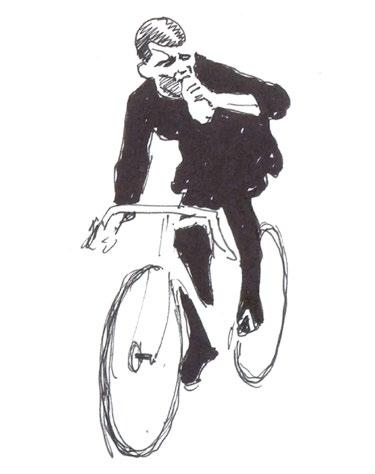
Tommy’s plan to win the coveted year-record was simple but brutal; he aimed to cycle 200 miles a day, broken down into 4 x 50 mile ‘chunks’ allowing time for food and rest.
On the longest day of the year, 21st June 1939, Tommy rode a total of 361 miles. Had he watched the summer-solstice sunrise over Stonehenge, at the end of the day he could have been sitting down to supper in Paris.
By October 26th, Tommy had achieved what he had set out to do, and much, much more. The year record had not only been won, but with 66 days to spare, he had time enough to smash the previous record – and put it beyond reach for all others who would valiantly try, yet fail for many years to come. Even after Tommy had completed the year-record challenge on 31st December, he didn’t just hang up his cycling shoes and take it easy in 1940. Just the opposite, he carried on riding huge mileages until mid-May.
Tommy, not entirely satisfied with the greatest year-ride of all time, wanted to push on further to gain a secondary record of the fastest completion of 100,000 miles! René Menzies, a previous holder of the year-record, had set the 100,000 mile target at an impressive 532 days.
By this time the restrictions imposed by an escalation of World War II were starting to make problems for Tommy. Besides the threat of a callup to serve his country, Tommy was also hampered by severe penalties for failing to abide to blackout restrictions and by dwindling food supplies. Nutrition bars and gel sachets weren’t an option for Tommy. His diet was very simple: bread, milk, eggs, cheese – and even these became scarce as rationing began.
Tommy rode two bikes during the course of his record-breaking ride. The first, a ‘Ley TG Special’ was custom built at the request of Tommy’s employer and sponsor, Mr A. T. Ley. The frame was built with Reynolds 531 tubing with high pressure 27" Dunlop tyres, a Brooks saddle, Solite front hub and (initially) a Sturmey-Archer three-speed hub gear.
The bike rode well and had been put together with durability in mind. However, huge mileages and poor road conditions would lead to excessive wear on the bike, and the costs of spare parts and bike maintenance ultimately became too much of a burden for Ley Cycles to bear.
Arrangements were made for a new sponsor to step in to support Tommy’s record-attempt, and it was
8
In a modern age of millionaire golfers and petulant footballers, Tommy’s achievement serves as a useful reminder of what true sporting prowess was, and can still be.
the Raleigh Cycle Company that were most keen to be involved.
Tommy’s new bike would be a Raleigh Record Ace. A four-speed medium-ratio Sturmey-Archer hub gear, which had been fitted to the Ley TG Special in March, was brought over to the new bike for continued use.
Although the Raleigh was cutting-edge technology at the time, it was still a 14kg-ish bike – compare that to the 2kg frameset of a top-end modern bike like the Specialized S-Works + McLaren Venge.
Besides the differences between Tommy’s bike and modern machines, Tommy also didn’t have the benefits that professional riders have today with regards to clothing, accessories and personal maintenance. Lycra, breathable man-made fibres and lightweight waterproofs were not an option in 1939. Tommy would wear thick tights and heavy woollen clothing that would often be wringing wet at the end of a day’s ride. Endless days in the saddle were taking their toll and Tommy suffered from saddle soreness. After limited success using ointment to relieve his suffering, on the advice of a female cyclist he donned a pair of ladies silk undies and greatly reduced his discomfort!
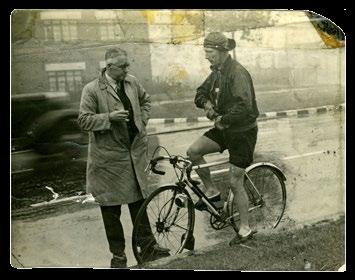
The pressure increased further on Tommy and his quest to gain the 100,000 mile record. The UK had experienced a particularly harsh winter at the start of 1940, and the roads were treacherous, with huge amounts of ice and snow covering the country.
Tommy had a terrible time in the freezing conditions, often skidding and falling from his bike. Damage to the bike, and also to himself, were all too common and simply had to be endured.
Eventually the winter broke and Tommy had the chance to pile on the miles. He was back on track to beat Menzies’ record. On May 13th, 1940, Tommy rode into Paddington Recreation Ground Track; at long last, he had the finish line firmly in sight.
Watched by his sponsors, cycling friends and other dignitaries, Tommy rode the final mile of a legendary journey. Tommy had bagged yet another
emphatic victory. Perhaps as an effort to help make the statisticians’ and sports writers’ jobs easier, he had covered the 100,000 miles in 500 days straight; a simple sum to work out that he had averaged 200 miles a day.
Tommy was called up to the RAF very soon after the end of his record-breaking ride. No chance to rest, or to reap the deserved publicity or financial rewards of his achievement; it was a tough break.
After the war, Tommy wanted only to return to cycling – and to race once again as an amateur. However, despite the best efforts of Tommy and his friends (several hundred of whom had signed a petition on Tommy’s behalf), he was unable to do so; the cycling governing bodies having ruled that once he had ridden as a professional he would be forever barred from amateur status.
Putting this huge disappointment behind him, Tommy concentrated his efforts on coaching and helping others. He became team trainer to the Stone Wheelers and was a huge supporter of the club throughout his life.
In 1975, aged 63, Tommy died while returning home from a ride with friends to Tutbury Castle. It seems fitting that Tommy’s last day on earth would be doing what he had loved doing all his life: riding a bike.
Tommy Godwin rode further in one year than anyone else in history. He is still the ‘Year Record’ holder and the record will remain his in perpetuity.
After hearing about Tommy Godwin at the Spin LDN cycle show, Boneshaker went home and found the excellent website tommygodwin.com designed by Phil Hambley and the team at Scribbletribe Studios. It’s from this site that the above text and photos have been taken, with kind permission. scribbletribe.com
Tommy Godwin’s story is told in detail in the book ‘Unsurpassed’ by Godfrey Barlow.
9
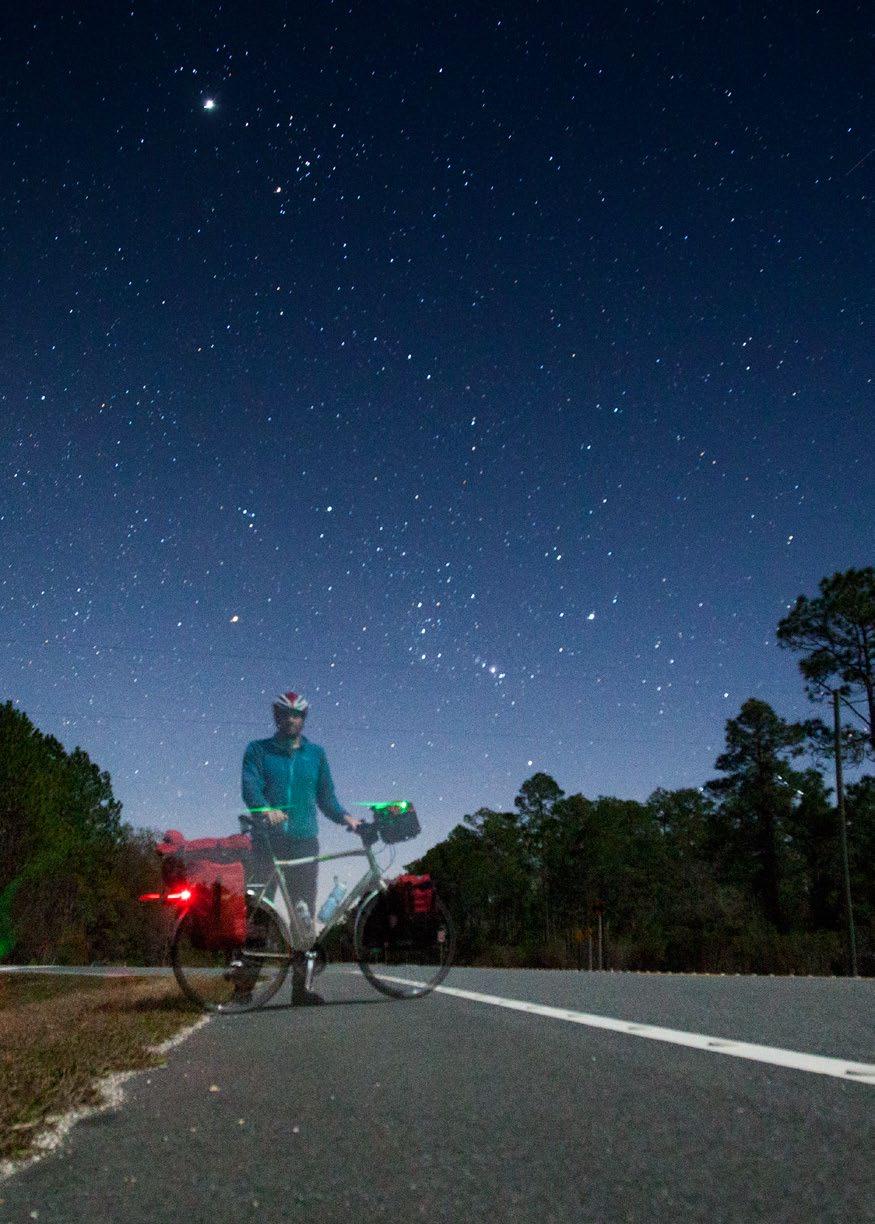
THE UPS & DOWNS OF A YEAR-LONG BICYCLE TOUR
WORDS & PICTURES BY DAVE GILL / VAGUEDIRECTION.COM
It was the end of spring, and it was another day at the office. A drag. A chore. A career path that I didn’t believe in. Later, I’d realise that this was the day that shifted my direction. It was the lightbulb moment, when I decided to quit, fly to New York and set off on a year long, 12,000 mile cycle touring adventure.
There were too many questions going on in my mind to stay, and my eyes would drift to the window with every spare moment. Why am I here when there are so many adventures to be had out there? I looked out, imagining travelling a long way by bike, using the imaginary ride to break the monotony.
It typically goes: newly independent men and women step into ‘the real world’, climb onto a career ladder and make upward steps, hoping to make their mark. They find partners, buy a home, have children and earn enough money to be comfortable. Fine, but why? Are those really the milestones that life should be based around? If they are, then awesome. But these don’t strike me as unreasonable questions to ask, considering our lives get shorter every day. Don’t we owe it to ourselves to explore the answers?
What I’d been seeing every day recently were the glazed-over eyes of people walking down the street who had either learnt that this model was the right one, or had just accepted it without question. I’m not convinced, even though part of me wishes I was. To me, they were drones, robots, automated capturedlives dedicated to a fantasy of contentment and a wish for fullness that might never come. My fear is
waking up as an elderly man and having a moment of realisation: as pleasant as life may have been, I’d lived a life that someone else had prescribed. It didn’t belong to me because I didn’t choose it, or even question it. I was just another old dude who’d taken part in a lifetime performance because that’s what we do. If I didn’t take action, I was on track to nonachieve the same fate. Suddenly a year living on a bicycle seemed like the most sensible thing to do.
I was in my early twenties, and as overly dramatic as it may sound, there’s something about hitting that age. It’s really the first time you realise that mortality is waiting for us all on (hopefully) a distant horizon. It’s oddly quantifiable - with good fortune we probably have around two-thirds of our lives left. But where did the first third even go? Wherever it went, it went fast. This isn’t a dilemma about death, it’s a dilemma about life and what to do with the single chance we’ve got.
Two months later, I packed up the used Trek that I’d found for a bargain price on eBay and set off with no idea what to expect. My panniers were full of unknown. No prior experience. No training. It was probably a bit foolish really. It was November 2012 when I landed in New York City from England, and it was the start of an unusual year. It was the learning that happened throughout the journey that surprised me the most. Learning about this type of lifestyle, about cycling, about the perils and the kindness that frequent being on the road, about people from all walks of life, about myself. The first few weeks on the road were a bizarre mix of hard and easy.
11
Physically it was hard, but I’d been expecting that. My view up until the first American pedal strokes had been that the journey in itself would act as training. It was going to be so long anyway, that prior training may have just put me off the idea completely. Prior to day one, I’d never cycled more than ten miles, and suddenly here I was riding all day. 58 miles. 81 miles. 63 miles. 47 miles. I couldn’t remember being more sore and in pain than those first weeks. The mental game during that time, though, was easy; constantly upbeat, happy about such a change, excited to be out putting in long hours in the fresh air day after day.
Gradually, the mental and physical parts shifted. Physically, my body adapted. The once horrendously uncomfortable leather saddle became pleasant. Legs grew stronger, muscles became less sore, and it quickly became easy to cover long distances. Mentally though, there was a reverse.
It became a roller-coaster ride of emotion: happiness, depression, anxiety, confidence, disbelief, excitement, joy. The entire emotion-portfolio, but lacking any kind of consistency.
It was around eight weeks into the trip when the first wave of negativity hit. Intense lightning storms meant that I was sitting it out, just waiting, relegated to a small tent on a plot of wet grass next to a train station in rural Louisiana. It’s the isolation that does it, that really gets to you. I began to severely miss family, friends, non-temporary human connection, a fixed base. I sat out the three-day storm away from any other people, without a phone signal or internet. Just the intense noise of rain on canvas, the knowledge that my bike was probably getting soaked, and a pot of bland pasta. It might not sound like much, in fact to some people maybe it sounds quite idyllic, but 72 hours without any form of communication with anybody else was enough time for the dark questions to emerge. Was it fair to leave for so long? To just up sticks and leave for a bike ride?
After a while, this negativity turned back to the reason I was here. For positivity and change; for growth; because I wasn’t happy. The roller-coaster went from low to
high, just like a decent one should. Enough time went by to adjust to the lifestyle shock, develop efficient methods of getting by and keeping things dry, and to master the temperamental ride that is bicycle travel.

The journey took me up hills that made me curse in Texas, and down the same hills that made me scream with joy, across green chilli farmland in New Mexico and through rare snow storms in the Arizona desert. Frozen water bottles one day, sweaty t-shirt the next. No new day was the same as the one before. Each had new people, new places, new experiences.
The great days on the bike were truly that. I’d wake up to a sunrise by a lake or next to a mountain, take it all in and then set off for somewhere unfamiliar. Big long days that just click. There’s a rhythm that’s created by pedalling and a flow that happens whilst seeing the world pass by under your own steam. I switched off and the hours flew by, a meditative state like I’d never felt before, all because of cycle touring. It was like an inner switch that took a few hours to reach, but once turned on, an intense clarity would come over me. I was more relaxed, and more present, than I’d ever felt before. This felt like living.
12
Following five months of pedalling down, across and up the United States, I’d arrived in Stinson Beach, Northern California. The previous night, after cycling by bike-light, I’d rolled into the town and in the darkness had stumbled around to find a stealth-camp spot in a State Park by the beach. A remote sandy beach overlooking the Pacific. This was one of the best parts to living on a bike –realising the beauty of our planet.
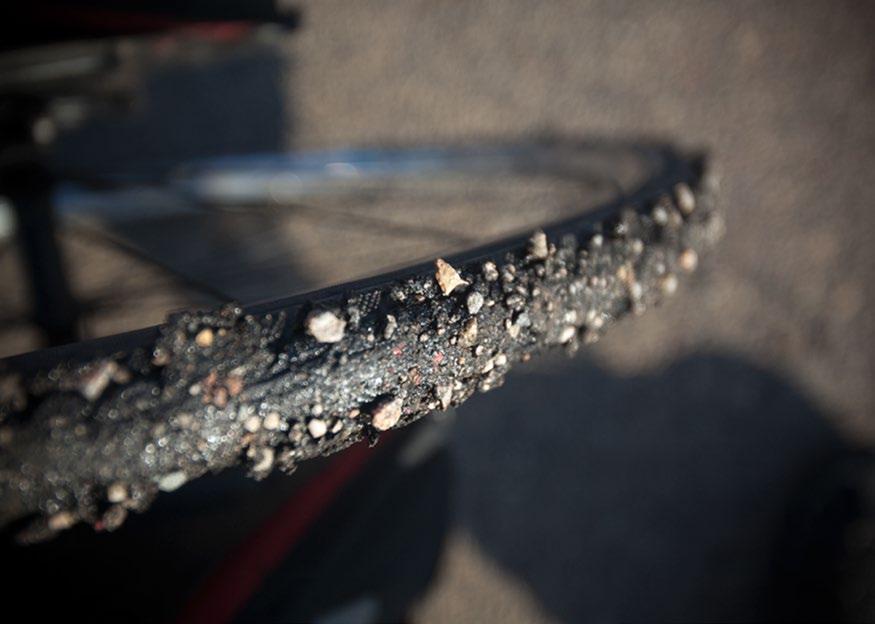
“Get Up! Get Up! You’ve got 5 minutes! You’d better be out of here when I get back!” Maybe it wasn’t such a beautiful moment after all. It was 5:45 am and a blurry figure was kicking the canvas a few inches away from my face. Alright, OK!
The blur turned out to be a park ranger on his morning duties. Oops. In all honesty, this kind of situation wasn’t that uncommon. Stumbling out of the tent, and exhaling the daily sigh of relief when I saw that the bike was still there, I began to pack up and realised that someone else was experiencing a similar morning. Yawning and rubbing his eyes from a lack of quality sleep, Brad had been sleeping on the beach.
Months before setting off, I’d made a decision to split the journey into two. Just going for a big ride wasn’t enough. I wanted to also use the journey to explore contentment and doubt with others.
Along the way, I’d been meeting up with a variety of people to talk about whether they’d experienced the same questions, and to record their answers through film. Did they enjoy their path in life? What would they change and do the same? Some of those encounters were pre-organized, and others happened by chance, but out of all of those meetings, from singing cowgirls to Hollywood directors to hunters, it was meeting Brad that was the most memorable.
We both grabbed our stuff and walked to a nearby basketball court as the sun was rising over the Golden State. He recalled growing up in Boston, where as a teen he was caught dealing drugs and ended up being sentenced to two years in jail. Eighteen months into his sentence, Brad had a bad day, got frustrated by the guards and ended up punching two of them. Because of the fight, he was given another eight years inside. Bringing his total sentence to ten years. A decade.
13
THE ONLY THING TO DO IS DEAL WITH IT, WORK IT OUT AND ACCEPT HELP WHEN OFFERED, BECAUSE DOING SO CAN LEAD TO GREAT, UNEXPECTED THINGS.

14
That’s enough to shock most people, but it was a fraction of the story. As Brad successfully shot hoop after hoop, three pointer after three pointer in the California morning glow, and I constantly missed the basket, he told me about what happened after prison. On his release, he was dropped off in downtown Boston with a $60 cheque. For a moment he looked around, and the best thing he could think of was to go back to prison where his needs were met. The tempting option was to punch a crossing guard and return to what he knew best. Instead, he walked for 15 minutes to clear his head and weigh up his options. And it was in those 15 minutes, whilst walking, that a new plan formed. He’d leave Boston, and walk. He’s walked for 13 years, taking in 38 states and thousands upon thousands of miles.
It was completely by chance that I met Brad and learnt his story, and it made me question fate. Was meeting him an always-meant-to-happen moment? Suddenly, the concerns and questions I’d been wrestling felt valid. Brad had changed his life by setting off. He’d turned his life around. That word, life. So grand, so vague, so many variables. But here was a guy living life, embracing every day. He didn’t have it easy, but he seemed truly happy, and that positivity was contagious. For weeks after that, during the tough times, the times when the hills never ended, or illness kicked in, or the homesickness seemed unbearable, I tried to remember Brad, and I appreciated the days much more then.
But when I arrived in British Columbia a couple of months later, after weeks of cycling into a headwind, another dark part of touring reared its head. Mechanicals. My load was heavy. Clothes, sleeping equipment, stove, food, camera, laptop for editing and writing. So what on earth was I doing with a flimsy 32hole rear rim? Any experienced touring cyclist would’ve called me an idiot. A few actually did. Every day I woke up, cycled for a few hours, and snapped a spoke. Sometimes three.
It’s an easy fix of course - simply a case of getting a decent wheel with a lot of spokes. I should’ve known, it should’ve come up in research, but remember I was inexperienced and foolish going into this.
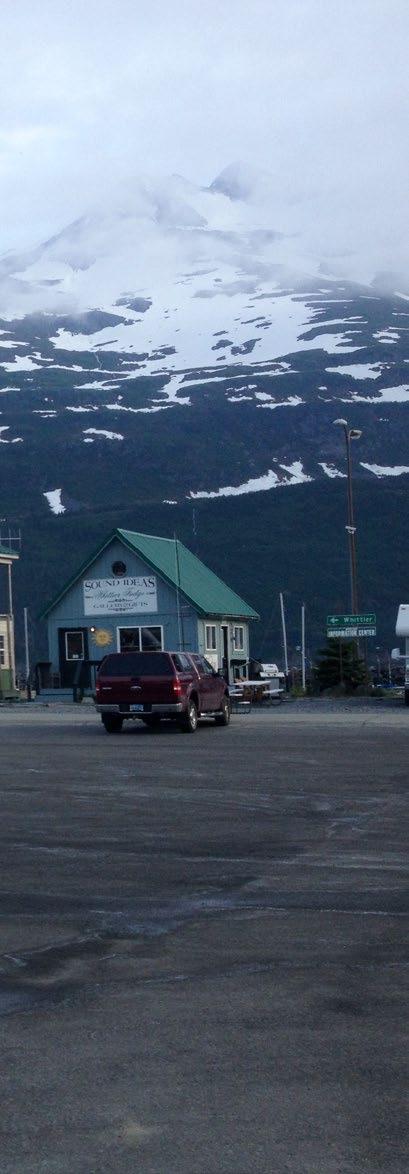
15
IT’S THE ISOLATION THAT REALLY GETS TO YOU. I BEGAN TO SEVERELY MISS FAMILY, FRIENDS, A FIXED BASE…
I was operating on a minimal budget because of the duration of the journey, so the thought of shelling out a month or more’s food money on a new wheel was something I was pretty keen to avoid. It was a daily disaster that took its toll - I just hoped that the spokes that snapped would be non-drive side so I could replace them on the fly. Eventually it became such an annoyance that I did purchase a new wheel, but not before my rim was an egg-shape and riding became a truly wobbly experience. There were many times that things went wrong on the road. And it took me a long time to realise the benefits when everything goes awry. Often I’d get angry and frustrated and scream to the sky, but then I realised that it’s these moments that count.
When I was on my knees at the side of the road with the bike in pieces, somebody would drive past, stop, and ask what was going on. They’d offer expertise, a hot meal or a place to sleep. It did wonders to restore my previously cynical faith in humanity. Those moments lead to great memories and even greater friendships. Invites into a cabin overlooking a lake with Buddhists, or into the spare room of a Canadian police officer’s home. Nights spent around delicious home-cooked meals which were so refreshing after periods of sustained tent life and a granola diet. Steak! It took mechanicals to help me see that whether it’s a snapped spoke, a broken chain or a run of bad luck in general life, the only thing to do is deal with it, work it out and accept help when offered, because doing so can lead to great, unexpected things.
It’s easy to look back and realise, in hindsight, that the hard times were valuable. In the moment it’s much harder. You’re in it, and hard is hard. The final few months did feel like hard work, sleeping rough, scary roads and insane truck drivers, the ever-approaching winter. Nights spent searching for warmth in abandoned barns to avoid getting snowed on and the slow, frosty mornings that followed.
As New York filled my sights from the final Canadian city of Niagara Falls, I felt hesitant. But not because of any of that; that was bearable. It might not’ve been fun but it was just the way it was.
Instead I was hesitant because it was coming to an end. Life on the move had turned into something I’d learned to cope with. A comfortably uncomfortable lifestyle. The thought of stopping and returning to a life based in one place had grown scary, far more than a thin road shoulder and a logging truck.
The final day, day 368, was an easy one. Miles had long become irrelevant and that afternoon my mind couldn’t have been further away from the act of cycling. It felt bigger than that. All the people, the experiences, the memories. The good and the bad. Internally I was focused on the previous 367 days and what they symbolized. Then, and without really realising it, I pedalled over the George Washington Bridge cycle path and arrived quietly in New York.
The Big Apple, the biggest city in America, was like a metaphorical sledgehammer to the face. My days had been mostly in between towns, quiet and secluded, and here I was where everyone was getting on with it, going about their lives, taking the subway home from the hustle and bustle of the daily grind. It was a shock because it marked the end. The ride was done.
A year of cycling and an overly ambitious goal had come full circle. Initially, because of the culture shock, I felt intensely sad that it was over. But after a few hours of taking it all in, that turned to optimism and a realisation about what the previous year had meant.
Sometimes we have to invest in ourselves and the simple act of pedalling and meeting people was my way of doing that. It brought with it so much learning, the kind that only comes from getting out there and chasing new experiences. I learnt to stop being intimidated and anxious, to turn dreams and ambition to action, to roll with the punches that are given to us, that grit and determination beat skill and experience, and that humans are kind.
They’re priceless lessons learnt from the road that I’ll hold onto forever. Riding a bicycle for a year altered my outlook, shifted my priorities and truly changed my life.
16
THE THOUGHT OF RETURNING TO A LIFE BASED IN ONE PLACE HAD GROWN SCARY, FAR MORE THAN A THIN ROAD SHOULDER AND A LOGGING TRUCK.

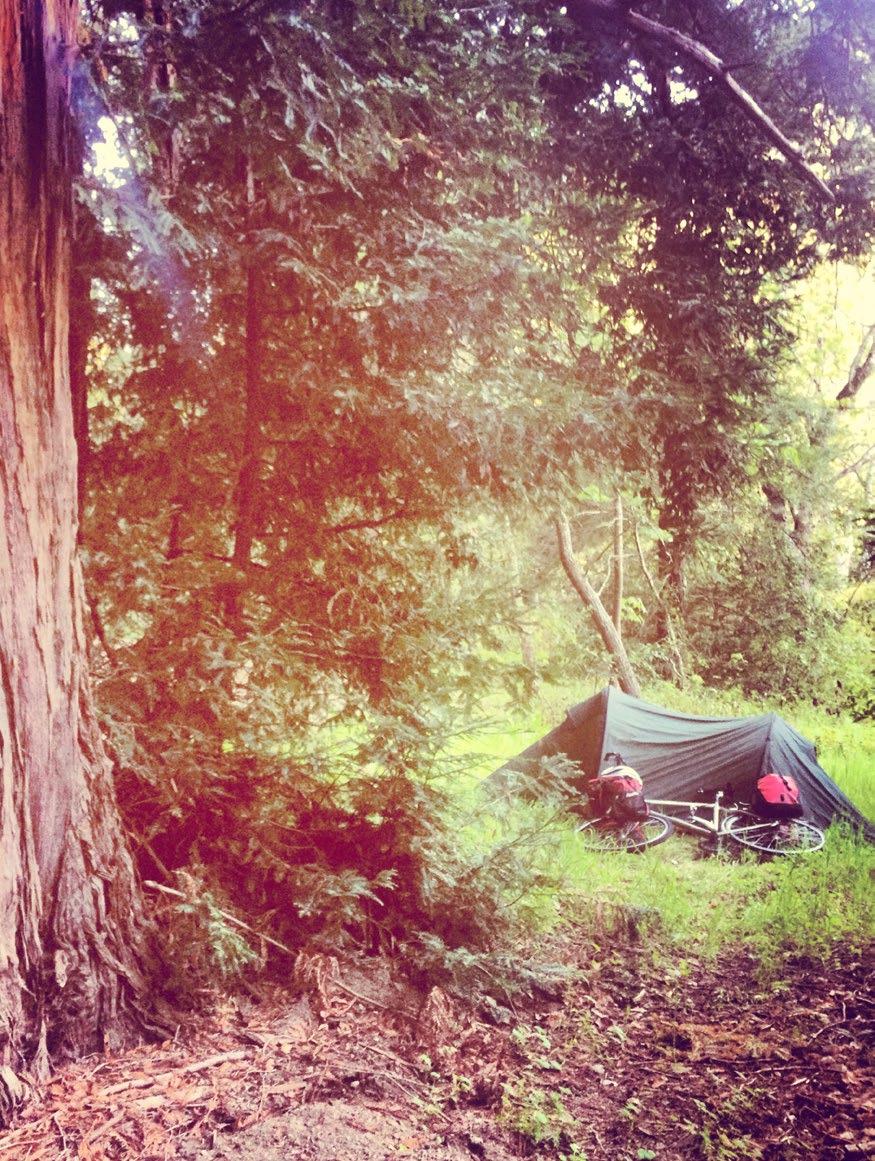
17
BEETLES BIKES
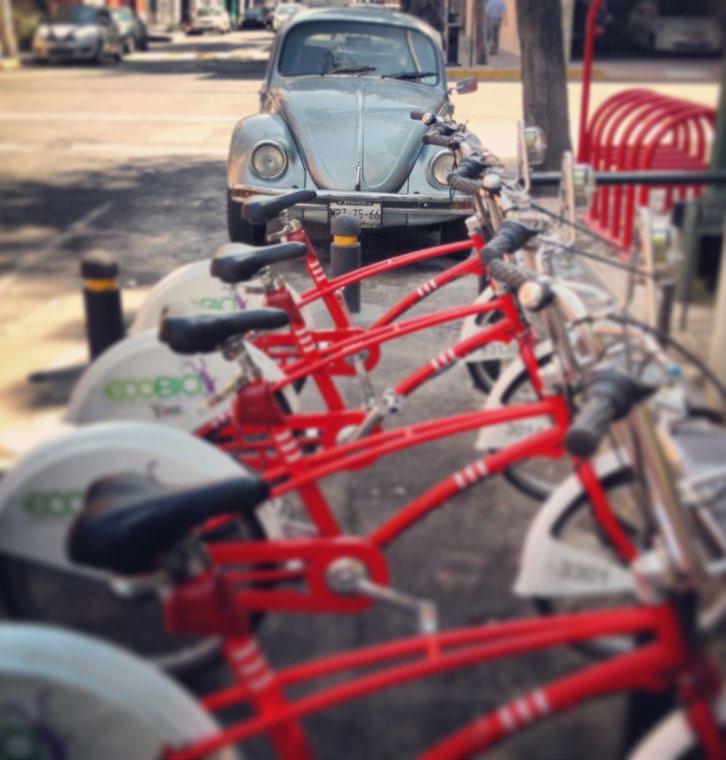
WOR DS & PICTURES JUDE BROSNAN / ISPEAKBIKE.BLOGSPOT.CO.UK
PERHAPS
When you go around with a name like ‘Jude’ you get A LOT of Beatles references thrown/sung at you. It’s no wonder I feel an affinity with VW Beetles. I feel like they understand.
I first visited Mexico in 2000 as an excited 18-year-old on a gap year and fell head-over-heels in love with the country. Over the last decade (plus a few years) I’ve been lucky enough to return to Mexico several times. While I was cycling around

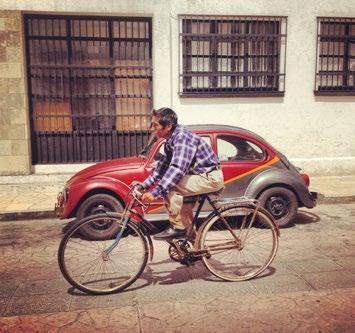
Mexico City a year ago, I noticed that there were many more bikes on the road than VW Beetles.


In the 1960s a Volkswagen Beetle factory opened in Mexico and they soon became the country’s standard box car. VW Beetles, or ‘Vochos’ as they are lovingly nicknamed, were a symbol of modernity and Mexico’s economic growth. Green and white Beetles (vocho verdes) even became the official taxi.
What’s interesting is that over the years these cars have begun disappearing while cycling has taken off. As I rode around, I started taking pictures wherever I saw a bike and a Beetle together. The car usually represents modernity while the bike is seen as traditional – these pictures question that perception. Perhaps Mexico’s outnumbered Beetles offer a small glimmer of hope that the future will ride on two wheels...
MEXICO’S OUTNUMBERED BEETLES OFFER A SMALL GLIMMER OF HOPE THAT THE FUTURE WILL RIDE ON TWO WHEELS…

ELECTRIC PEDALS
The dynamic future of community cinema
 Images
Words
by Colin Tonks
by Zoe Howes-Wiles
Images
Words
by Colin Tonks
by Zoe Howes-Wiles
The lazy weekend sun is setting over Telegraph Hill, south east London, as the local community flocks to an unusual outdoor screening of Grease. They bring their children and their camping chairs, their vintage glad rags and woolly jumpers, their sparklers, flasks and bottle-openers. And of course, they bring their bikes –for tonight’s screening is powered purely by legs.
The atmosphere is charged. Children play on bikes as Pink Ladies gather, swirling around with champagne flutes and blond curls, unpacking picnic hampers to celebrate the night in style. Couples pedal side-by-side as the T-Birds arrive. In grunge black leather they ready themselves with beers and blankets. Fathers and sons discuss gear-changes as the BBQ smokes-up, the city lights up, cameras flash and movers and shakers dance to Motown. All around, cyclists pedal away on bicycle generators; tonight, they are the stars. They are the batteries generating the electricity to power our Saturday night entertainment. Welcome to Electric Pedals.
Electric Pedals was founded by Colin Flash Tonks as a way of harnessing human power to generate energy from cycling. Since then, the possibilities of bicycle power have radically developed. In Malawi, a young man sets up a backpack cinema in his village, surrounded by fascinated faces. In Berlin, the lights dim in Katie Mitchell’s pedal-powered production of Atmen as the actors momentarily pause to wipe the sweat from their brows. While back in London, it is
break time at Horniman Primary School and in the Radio Station Shed young eco-DJs mix with renewable energy. Electric Pedals has become the forefront of bicycle power innovation.
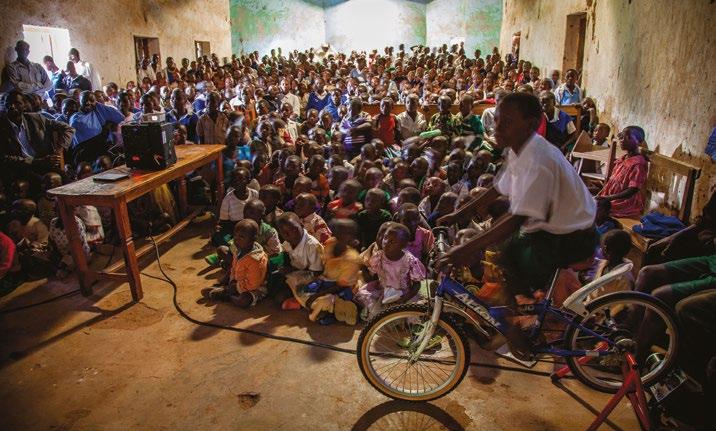
But it’s more than that, Electric Pedals is about communication. It’s about connecting people. Whether through outdoor entertainment or classroom education, the focus is on community. Electric Pedals’ collaboration with New Cross and Deptford Free Film Festival meant that more than 700 people came together to sing-along to ‘Greased Lightning’ and swoon over John Travolta. As Jacqui Shimidzu, Community Volunteer and Founder of NXDFFF explains, ‘we could have just had a generator powering this outdoor performance, but Electric Pedals brings added value. People don’t quite believe that cinema can be completely powered by themselves; it’s a spectacle.’
The how of cinema is redefining the extent of what cinema can now be. Dynamic and communal, active participation transforms cinema into an immersive and unpredictable performance where escapism becomes a team-effort - a shared experience - rather than the solitary silence of a dark auditorium. As Tonks makes his last directorial adjustments to the 20 bicycles that will power tonight’s screening, he admits the everpresent ‘fear of jeopardy’ in producing this kind of live cinema: ‘It could all still go wrong.’
And it did.
22
Relying solely on constant, real-time pedal power throughout the screening meant that when the human batteries stopped pedalling, the film stopped reeling. Blackout. There was no back-up. With adrenaline surging to resolve the situation, the atmosphere was suitably electrified. The boundaries between picnicking neighbours broke down; red-lipsticked enthusiasts carried on singing regardless, sending a wave of encouragement back to the cyclists with a bawdy rendition of Summer Nights. Suddenly, the screen lit up and the music returned. Cheers rang out for the cyclists; the stars of the show were back on their bikes.
‘This is healthy cinema’, says one Goldsmiths graduate. ‘It’s like a little festival’, says another, ‘There’s a beauty to it’. There is. When something this positive brings people together, there is always beauty - and a world away from South East London, Electric Pedals uses bicycle-powered cinema to bring African communities together in just the same way.
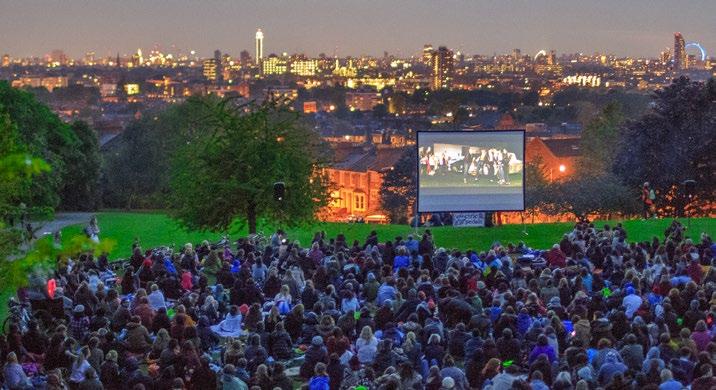
Back in 2009, in association with The Great Apes Film Initiative, Tonks engineered a basic pedalpowered cinema for a hilltop village on the edge of Mgahinga National Park, Uganda, consisting of just two mountain bikes that turned bicycle generators and powered a projector and guitar amp sound system. This conservation project needed to bring greater awareness to the local communities of the endangered mountain gorillas that lived alongside them. Through Electric Pedals’ lightweight and eco-friendly innovation,
even the most remote villages could be educated and entertained through film. For most, Electric Pedals was their first experience of cinema.
Similarly, last year Electric Pedals developed a pedalpowered cinema backpack kit trialled in Malawi. Malawi is 80% rural, and so while film is recognised as a powerful social tool, it is only applicable if it can reach (be carried to) the inaccessible communities. Being able to cross rivers and walk long distances through dense undergrowth, Electric Pedals provided a portable answer with their 20kg backpack cinema. The effect can hardly be overstated. The backpack kit brought the outside world to some of the country’s most farremoved places, raising aspirations, igniting ideas and stirring debate through the luxury of film. For most, it was a miracle.
When Grease’s finale song, We Go Together, rang out across Telegraph Hill, it seemed like the most natural thing to do to stand up and dance. Within moments, the entire audience was laughing and dancing, together. Without the constraints of auditorium seats, the cinema became a moonlit disco and Saturday Night Fever began. There is a beauty to it; how often do we cut loose and share a moment like that with our neighbours? Film can bring any community together to have fun and be inspired. And whether in the UK, where doors so often remain closed, or in the depths of rural Africa, where technology is minimal, Electric Pedals is pedalling the dynamic future of community cinema.
electricpedals.com freefilmfestivals.org gafi4apes.org 23
Julian Sayarer rode around the world, beating the record as he did so. Five years on, he looks back at the way the journey changed him, and the book, Life Cycles, in which he's gathered his thoughts from the road.
Words: Julian Sayarer
Illustrations: Paul Heredia

Me and the Bicycle
Throughout that journey, from a child to an adult, I suppose the bicycle became my touchstone, my talisman. Of all that will be sold away, please allow that the bicycle be the last thing to remain sacred.
I loved cycling through impulse, through instinct, and long before I was cursed to try articulating that feeling with words. Across the miles I’ve given it a great deal of thought, finally resolved that perhaps for me the bicycle represents some small saviour from mortality, the opportunity to make something greater of myself, to move with such speed and power that a portion of the mind is able to believe in magic, believe we humans are not after all so banal as I must otherwise confront. I love the bicycle like nothing else, the one institution I’m happy to live by, for in it you can feel euphoria.
Kash d’Anthe
It had started in Istanbul, the Cihangir crossroads, where I’d met a couple who were a year into cycling around the world. They’d told me of a Scot by the name of Kash d’Anthe, aiming to break a world record for a circumnavigation by bicycle.
Back in London I’d looked him up, and soon after, by chance, scarcely had to look for him at all… d’Anthe was well on his way to minor stardom, a subject for television, advertising and corporate endorsements. Come that time he’d broken the record, ridden 18,000 miles in little over six months, an average of 90 miles daily. The start of my curiosity was the feasibility of the target. Riding leisurely to Istanbul I’d averaged 70 miles a day despite lengthy breakfasts, no thought of haste and sitting in cafés scribbling stories for five hours each afternoon. And yet that alone would never have been enough to tempt me into the pettiness of that dumb record.
It was the manner in which d’Anthe went about his feat that roused my ire… snagged a pathological part of my personality I’m not the least bit proud of.
He was sponsored, up to the eyeballs he was sponsored… banks and investment funds all over his chest, his smiling face and a thumbs-up next to a business model that cared nothing for people or for bicycles, only the right numbers in the right columns of a balance sheet. I was well desensitised by then, didn’t expect much to be left sacred, but it was the final straw… to see the bicycle reduced to no more than a corporate marketing strategy. We had things in common… d’Anthe and me were not so very different, both in our mid-twenties, both politics graduates. I couldn’t fathom how someone of such similar years and education, of the same passion for travelling by bicycle, could come to hold such different priorities.
His pitch was a strong one, a stroke of genius. The financial sector he endorsed was without heart or love, working only for financial gain, and so the undertaking, ostensibly for spiritual gain and the joy of the task, was perfect. Their business wore suits and worked in skyscrapers while d’Anthe would see those who still lived in huts and dressed in loincloths, all traditional-looking to offset the garish and the modern. Finance wanted to be brave, to be beautiful… finance wanted to be adventure. They loved d’Anthe, were ready to make his whole life easier. They threw money at it… he sold… and with a smattering of charity thrown in, the banking world purchased a tiny piece of the human spirit.
I decided to go around the world, faster than him, and without bankers billowing my sails. The following excerpts are from the book I’ve since written about that ride.
25
Russia – Day 27 – 2,801 Miles
It was enormous. Russia. A place in which to realise just how you squandered all your superlatives of size back in the Ukraine. You see the trucks coming down the road from five kilometres away… thin pipes run above the wheels, trickle water to quell the heat that builds in the tyres. Road signs show cities 1,000 kilometres in the distance. The people are silent. They’d planted trees, twoskin deep, all along the roadside. It was so you couldn’t look out, out into the abyss, that endless vast that would creep into your mind and drive you insane. Occasionally at crossroads I would catch a glimpse of that sea I swam in, where I could drown in land long before there came a town in which I might slake my thirst and revitalise. As I rode, I saw squares, off-colour rectangles drawing closer. Houses, habitations… I thought I’d made it, that I was saved. And then I neared, and those squares and rectangles were only the spaces between the trees lining still more endless fields. Green, gold, brown and ploughed, black and ashen, the thing that never changed was it would always be only another field.
Kazakhstan – Day 35 – 3,722 Miles
In Kazakhstan I spent over 2,000 kilometres on a single road with hardly a turning, a gallon of water carried over my back wheel, pannier full of bread and jam, a head full of worst-case scenarios in which my bicycle broke down between settlements. The villages were 100 miles apart, then 150, and eventually 200. Imagine London were only a village, Manchester were another, and now imagine nothing in between upon that single road that joins them. You can see the towns in the distance, a single radio mast stands skinny against the horizon, comes slowly into view from 30 miles away. Kazakhstan is the ninth-biggest country in the world but with a population of just 16 million. I rode through some 3,000 miles of it… find it hard to believe even that many people are living there. The land delighted in its endless scrub, and among those wastes I found myself smiling, simply smiling, for never have I been so at peace. The steppe was just a mirror, could comfortably represent either stark death or perfect simplicity, and each time, against that landscape so eternal I realised all I saw was in fact only a measure of my own impatience or contentment. Out there I was humbled, so tenderly was I humbled, for I took with me all my earthly weight… my cynicism, fear, my ego and insecurity… and, when we arrived in those wastelands, they saw the world in which they wished to live, so that very soon, all had fled from me.
At dusk I watched settlements from afar, eating a small meal before disappearing back into the road. Trails went, kicked up behind the goats, the horses and bulls being driven back inside the mud walls of the village. A bell would ring from a short tower, and I watched figures sitting lazily on horseback as they rounded up the herd, lines of dust making their way slowly back through the gate from different points on the landscape. Those sunsets in the Caucasus were something else, a tiny, nightly supernova, like a hot ruby sinking to the bottom of a well… you could light a candle on them, smouldering in a pink that turned to blood. Peels of black cloud would sit upon the red, leeches sucking that firmament to the last before floating to the tops of the sky, greying, and then melting to join the night.
For a while I’d lay awake, growing certain the stars were breeding overhead. Every night there were more, new stars appearing among the million, white waves of cosmos trailing among them. Sometimes I would stare upwards and imagine the outside universe as nothing but light, the world itself wrapped in a black paper bag with tiny holes, pinpricks all through the walls and roof of our resting place. In those lands there was no need for a tent… rain was impossible and the mosquitoes could not survive, the silence too absolute for their wings to hum through. The stillness would play a lyre as I looked up at the sky, resolving to keep my eyes open until a shooting star had passed. In most places I have lived, such a game would have failed entirely, yet out on those plains it comes within five minutes. The tail of that burning rock would take a needle from those scrub thorns, and together they stitched closed my eyelids each night. The scrub sat over me, bathed my forehead as if a warm flannel, soothed me to sleep beneath those acrobatics.
China and car horns – Day 72 – 7,333 Miles
The car horns, ever the car horns wore me down, screaming all day long. They screamed that I move, screamed that they were coming… no thing too complicated, no situation too nuanced for explanation by car horn. Each time, for a whole month, it felt as though my eardrum was being spliced open with a blunt dagger. I grunted, grimaced, shouted, grew ever more furious, but it was futile – the car horn is invaluable to Chinese culture, it props up the nation itself. That horn expressed all standard scenarios of the road plus infinite more besides. I imagined the hidden rage that horn must have buried in the population, grew convinced
26
Chinese society retained its order by use of that horn and the frustrations it nullified. I’m 5’2” and identical to half a billion others, listen to this horn! My culture, history and ethnicity are repressed, listen to this horn! They think they’ve made an emancipated woman out of me but all they did was give me a truck to drive through a desert, listen to this horn! I’m a homosexual but don’t even know it because of this crushing, sexual conservatism, listen to this horn! Ten per cent economic growth? Maybe on the East Coast, listen to this horn! China, a great nation, then where are our basic freedoms? Listen to this horn! The sky is thick with smog, rivers run black and my child coughs blood… listen to this horn! Listen to this horn! No use gesticulating either for, if I waved a fist at them in rage, they simply took it for greeting or support and let off another volley my way. No concern could not be raised and answered by the blast of a horn. Like a psychiatrist’s couch, it saved them from themselves, it was their dissent, their protest, their therapy.
Thailand – Day 88 – 8,943 Miles
Thailand was kind to me, the coast drawing me out through canals and estuaries, beneath highways that lifted traffic above the water before sinking into Bangkok. Evenings broke with the smell of incense lit, and I watched people leaving their houses, slipping on a pair of sandals, the heels of which would clap against the ground as they strolled to shrines at the bottom of the garden. They placed gifts, put flames to incense, said prayers and bowed, unscrewing the cap from a bottle of water and setting it down for the dead to drink.
I remember the monk, sitting in orange robes upon the rear of a pickup truck driving by. He looked at me with a smile, put out a level palm in front of him, pushed it towards me and picked something from it with the thumb and fingers of his other hand. In his grip he lifted some invisible ball of sorcery, and with a flick of the wrist, he cast it into the air, blew… commanded his blessings upon me as his outline pulled into the distance.

27

America – Day 100 – 11,356 Miles
Those first two weeks in America I was on holiday, rode the most generous Pacific tailwind and still turned out the slowest fortnight of the whole six months… all of it lost in discussion of capital punishment and gun laws, watching the Pacific, singing aloud, full of Dylan as every state in the Union went down into my soul.
Oregon. It was Oregon that really did it… it was Oregon that sunk me. I rode through Oregon, through Oregon, through Oregon… I want to ride through Oregon every day for the rest of my life. All down that coast you climb up into the forests. Climb up. Climb up. The road tilts, hugs cliffs, hugs hillsides, runs under cover of the trees until you reach the top and begin to pick up speed… lots of it… more still, and then you’re sweeping back down, and up ahead the dark of the forest gives way to the light of the sun, and you sweep out the forest so that the sun it hits everything at once. And the trees, they are emeralds… and the Pacific, it’s sapphire, and it all glows white in the sun, and the Pacific… my god, but the Pacific it’s such a good name for an ocean. Rocking and fluttering and sparkling, with the turning pages of books and stories and gossamer yarns. The ocean moved against white sands with their dusty trunks of driftwood, washedup and tossed to the beach, like dinosaur remains and whale skeletons, a cemetery of rib cages and tusks from creatures of another world.
I would ride down those hillsides, my head would fall to one side, my nose and the corner of my mouth would lift in enquiry, eyes glazing in search of clarification. Really… are you sure? Excuse me, but there must be some sort of mistake… for this cannot be. I died about five times a day down that Oregon coast, don’t hesitate in saying it ruined the rest of my life. The air from the Pacific made me sad to think one day I’d have to breathe the air of the deserts, the air of a city, the air of any place other than that Oregon coast where I rode my bicycle. I saw infinity there… that was the problem. Right there in Oregon I glimpsed infinity. The history of the world came down to meet me, revealed all of the serene chaos that wound up beautiful. I saw it all in the palm of my hand, and with it my mind blew open, so that afterwards, once I’d pieced myself together again, so it was that I saw how small I was against it all, my blink of an eye that passes for a life. I know I probably don’t seem so very old to most of you, down here and still shy of thirty… and yet, once you’ve seen infinity… you come to realise how soon your time is up, how quickly it all goes by. Live life like you’re dying… that’s what I’m getting at, my advice in all this.
Day 163 – Castille – 17,103 Miles
I rattled big days: 150, 150, 150, 150, 150 miles… five in succession, knocking them off the bat, one after the next, with an average three hours sleep. I still like the ideal, that back-against-the-wall sort of stuff … but even with that… I’m not so sure I was enjoying life much by then. I hit La Mancha… La Mancha hit me back with a force far greater than I had spirit to resist, Don Quixote illustrated in town centres and bars for 100 miles, riding with horse and lance through the windmills of La Mancha in the name of chivalry and ideals. I chased after him with my bicycle and panniers, just as hopeless, the end of my quest for a world bettered by circumnavigation. The end was in sight, the money all but gone, my enthusiasm for records long a thing of the past.
And now, looking back, I have a peculiar relationship with the ride in so many ways. Despite the good intentions with which I set out to break the record, riding a bicycle around the world presents so many experiences that teach you how silly the idea of records is, and I was never that convinced to begin with.
The idea of racing against someone else’s time was at lots of moments a lot of fun... perhaps even more so with hindsight, it’s exciting to remember waking up after a few hours rest and knocking out another 150 miles. That said, my fondest memories, really, come from the very steady, manageable, hundred-mile days I rode for the first three months, through central Asia to Shanghai. If not then, then the days in the US, when I forgot about the record altogether and just stopped to talk politics, or took it so beautifully easy as I rode the Pacific Coast.
I think the record adds something to the book that I subsequently wrote; it lends a good narrative, and a context of time that I hope distinguishes it from a lot of literature from the saddles of touring cyclists. The sense of wanting to change the world, and the ideals I set out with, offered some strong touchstones that I always found myself returning to. The people you meet, and their own life stories, never stray too far from those same values, and now that’s how I see my book in some ways, the story of the world by bicycle. Next up is the story of the city by bicycle, drawn from three years as a courier in London. I’m still developing as a writer, just as we’re all always developing, either as people, or in the skills we turn our hands to. That’s what keeps the wheels of life turning.
Julian’s book, Life Cycles, from which the excerpts above are taken, is out now.
29
Standing inside the pipe, our eyes looked up to the funnel’s beginning, as if we were tiny ants trapped in a sink’s plughole.
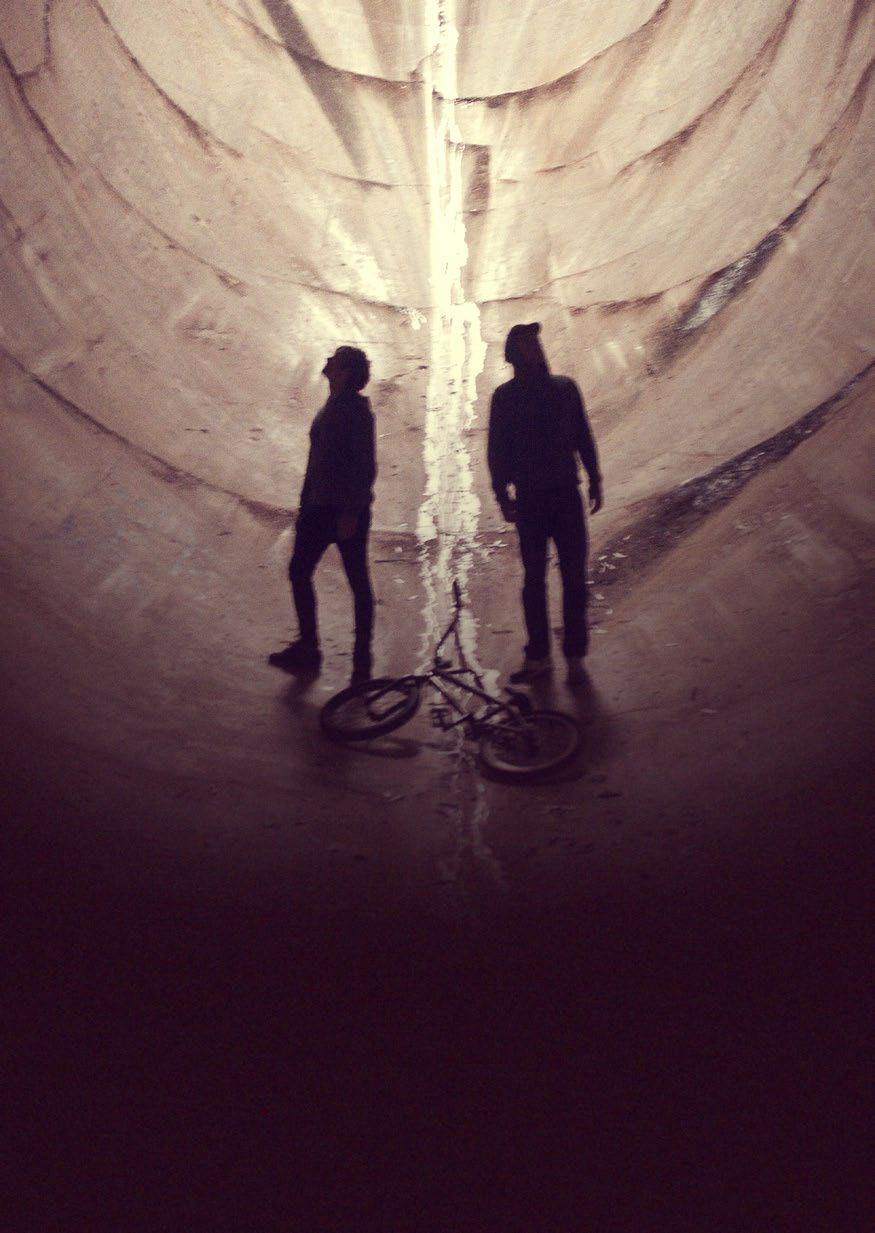
THAT PIPE!
“Duuude! What massive alien pipe is this?” Tony screamed. “Damn, that’s totally off the hook!” I replied. Bit by bit we recognized my buddy Steve’s new profile photo on the laptop’s screen. He’s proudly posing in front of an enormous fullpipe made of concrete. We’d never seen something that huge before. Tony was so excited. He was partying inside. “We have to go there!” But Steve’s reaction was a bit of a downer: “That could be anywhere in the outback. You’ll never find it.” Big disappointment.
We’re from Germany, but were in Sydney, where Tony was looking for jobs, each and every day. We were in Australia to see as much as we could of the country, going from place to place with a disassembled BMX in the back of our car.
One day we visited the BMX shop Steve was working for in Sydney. Deep in conversation with the shop’s owner, Mike, about rad spots in and around Sydney, I felt thrilled like a rat on ecstasy pills. Mike had printed off maps and marked heaps of riding spots all along the east coast of Australia. Poring over these maps Tony suddenly yelled “THE fullpipe!” Fortunately Mike had been at the fullpipe with Steve some weeks ago, and could mark out the route and tell us everything about it. Bingo!
We had the red pencilled treasure map. It felt like christmas, birthday and a lottery win on the same day.
 Words: Max Lehmann & Tony Haupt Photos: Tony Haupt / tonyhauptphoto.de
Words: Max Lehmann & Tony Haupt Photos: Tony Haupt / tonyhauptphoto.de
31
Alright. Tony didn’t find a job in Sydney and the weather forecast didn’t sound too good either. So we hit the road. Steve was definitely right when he said “It’s in the middle of nowhere”. We were driving for days at full speed, accompanied by rain, rain and some more rain.
We slept overnight in our cars, passing through tiny towns that looked like they’d been uprooted from some European country. ‘Skis and snowboards for hire’? Well, that was something mind-boggling. So we had a closer look at our huge map of New South Wales and suddenly it all made sense. We were heading slowly but surely towards the Snowy Mountains. As time and kilometres slid by, the roads were getting more and more narrow and winding. Bends for what felt like 200km, our ears aching from pressure. We crunched the last 25km along gravel tracks through milkvetch-fringed woods. After what seemed like an eternity we reached the end of a road, some 1600m above sea level. Suddenly a gorge and a vast dam appeared. Here we stood, with bated breath, waiting to see what we had dreamt of.
But at first glance there was no fullpipe to be seen, only a monstrous funnel-shaped thing. We had already clocked this via satellite photos on the internet as a suspiciously huge black hole, so we were sure we were in the right place.
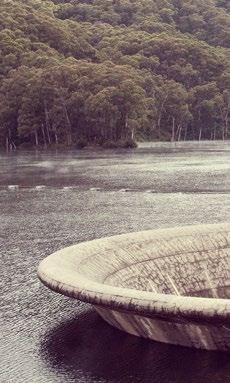
Obviously a fullpipe like this isn’t part of your typical skatepark. This pipe wasn’t built to go for a family stroll. The only readily identifiable above-ground signs at the dam were ‘DANGER’ signs. That pipe’s black hole acted as an overflow for the huge artificial lake above the dam. We knew we’d found an opening, but to actually get in there we needed to march another twenty minutes to the ‘entrance’ – the overflow’s emergency outlet. The end, so to speak. We fought our way across loose boulders and after a few adventurous climbing manoeuvres we were inside. Inside the pipe!
After what seemed like an eternity we reached the end of a road, some 1600m above sea level. Suddenly a gorge and a vast dam appeared. Here we stood, with bated breath, waiting to see what we had dreamt of.

32
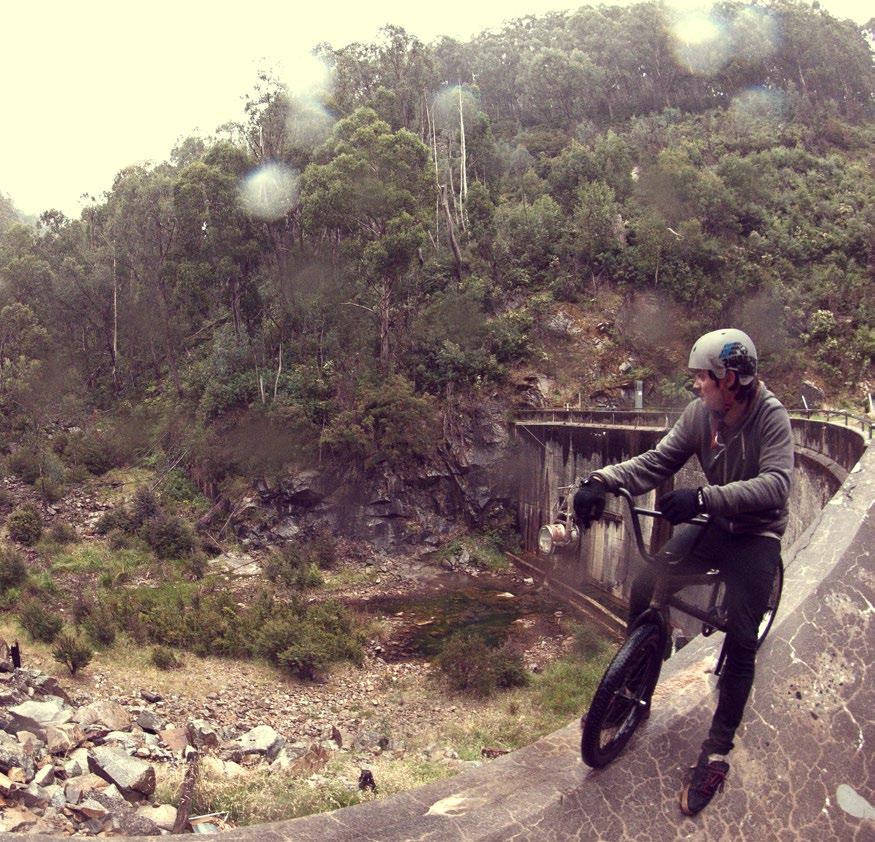


With every carve I got higher and faster, gaining confidence, swooping back down before pitching back up to those dark and dizzy heights.
The concrete was almost completely dry. We only needed to clear out the floor a little to get rid of the rubble before we were ready to carve a path around this alien channel. We inspected the 150-meter-long pipe. There we were, some 15 meters below the level of the dam’s stored water. Standing inside the pipe, we looked up to the funnel’s opening, high above. It felt as if we were tiny ants trapped in a sink’s plughole. With an uneasy feeling I rode my first cautious meters in that pipe. Uneasy, because if that emergency funnel was used we would have been washed out like ...ants from a sink’s plughole. The dam was already pretty much full. There were maybe one or two meters left that kept us alive - but it was raining, so we knew we hadn’t got much time. Since we love our lives, we shouldn’t risk too much.
But riding those strange subterranean curves was supernatural pleasure beyond description. With every passing minute the fun increased. With every carve I got higher and faster, gaining confidence, swooping back down before pitching back up to those dark and dizzy heights. I was deep underground and in the middle of nowhere. But I felt on top of the world and right at home.

34
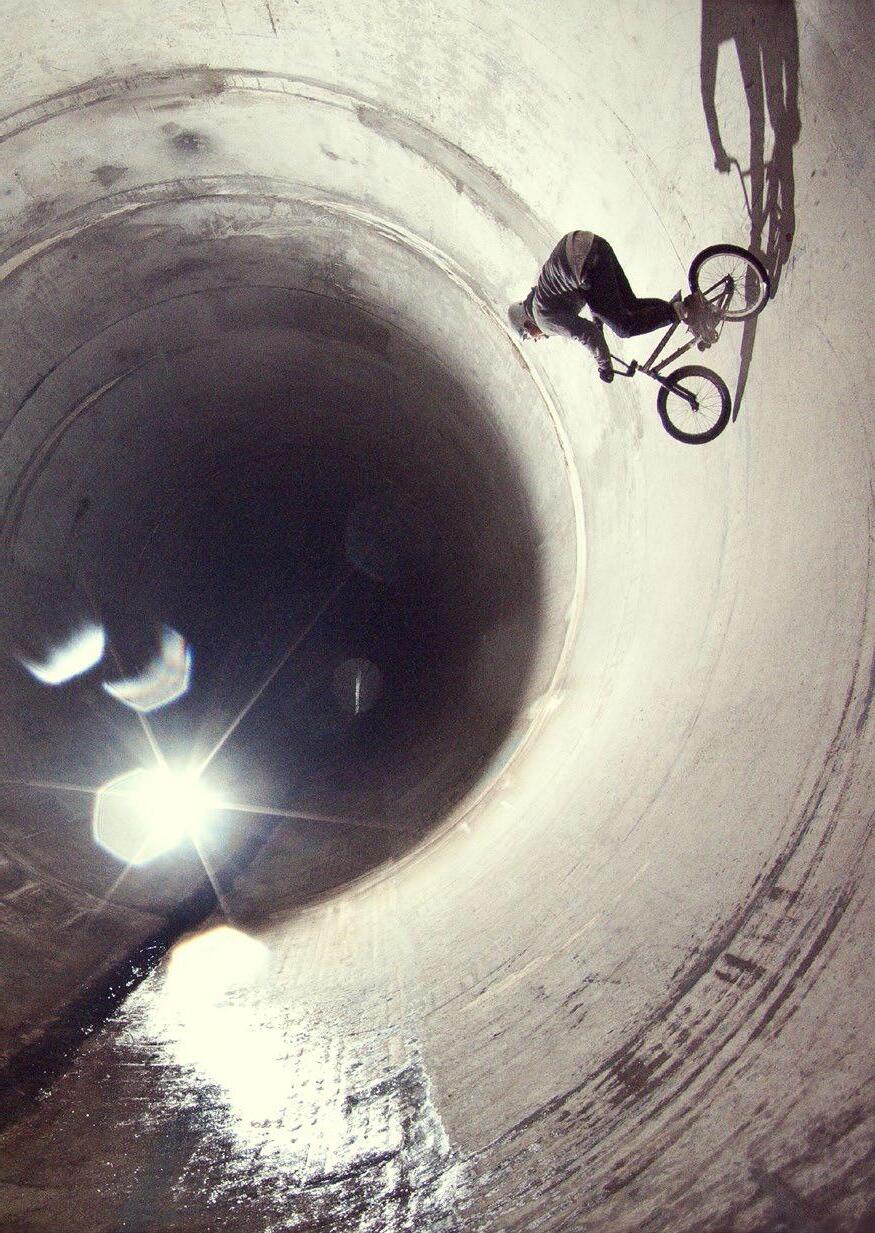
I was deep underground and in the middle of nowhere. But I felt on top of the world and right at home.

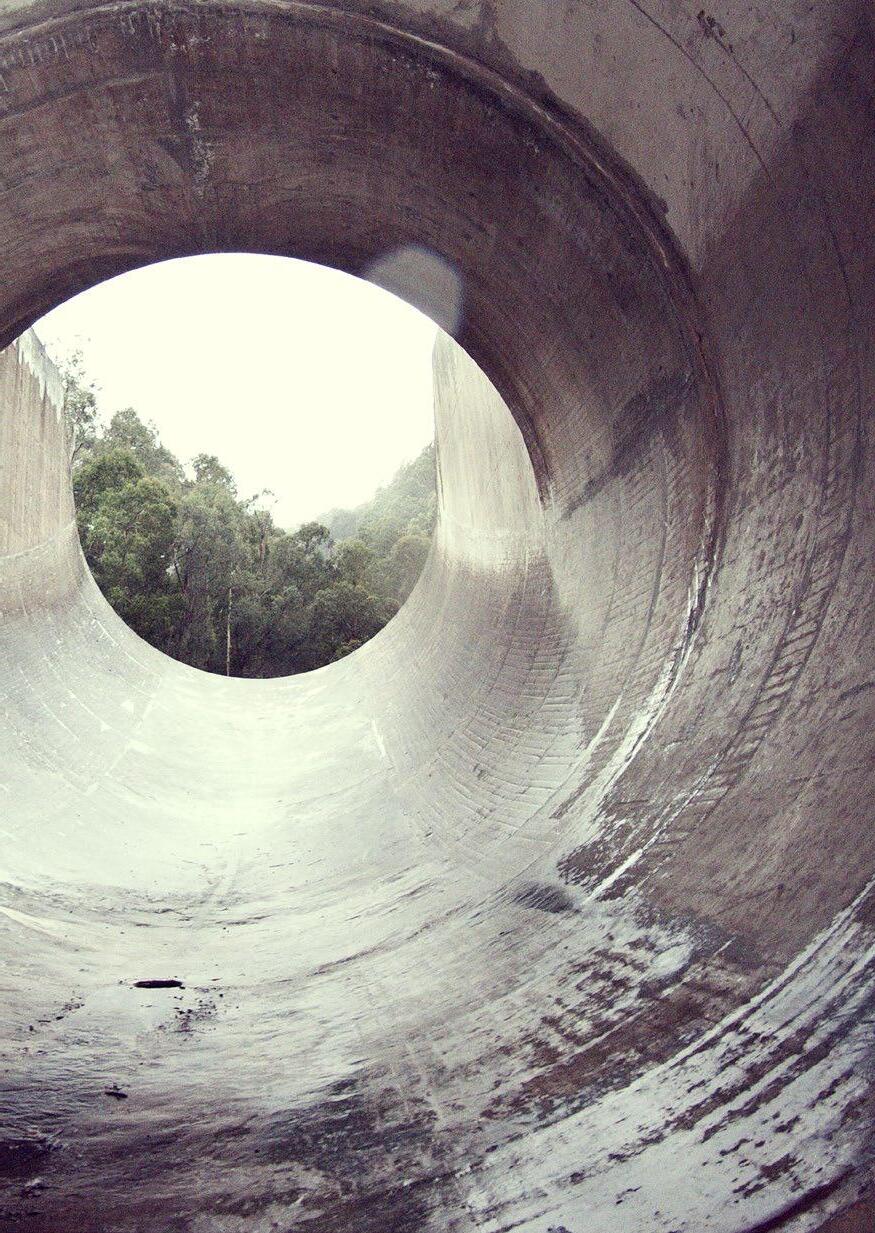
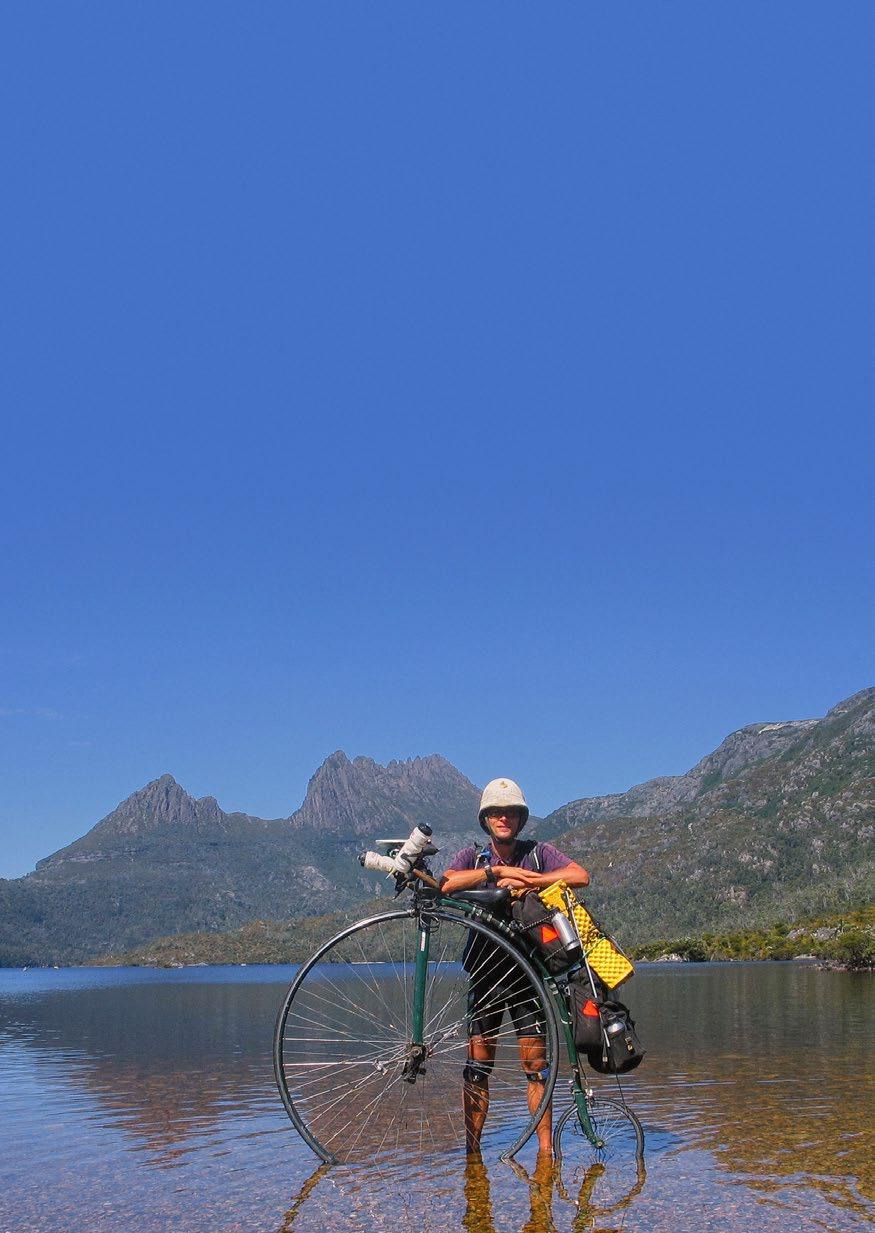 Photos by Joff Summerfield / calloftheroad.co.uk
Words by Marc Simper-Allen
Photos by Joff Summerfield / calloftheroad.co.uk
Words by Marc Simper-Allen
There’s an otherworldliness to Joff Summerfield.
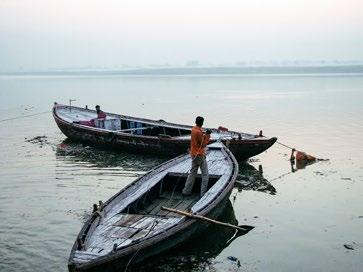
43, lean and spare, there’s something of the aesthete and visionary about him; it’s as if he’s discovered the meaning of life, and finds the world around him amusing, perplexing and all a little strange. He certainly has seen much of the world from a unique perspective: from the saddle of a penny farthing, and is only the second person ever to have done so. What makes the achievement even more remarkable is that he did it on a bike he designed and built himself.

Summerfield’s apparent detachment from the material world seems almost inevitable when you think about it. When a person’s whole existence, for months and then years on end, has revolved around a bike and the few possessions they can carry upon it, there emerges a peculiar and specific focus. Life is cut down to the essentials needed for day-to-day survival; the immediate problems of food, water and shelter. Those who have tried it know that it generates a feeling of complete liberty and self sufficiency, and that it’s addictive. That’s why Joff’s planning to ride around the world again.
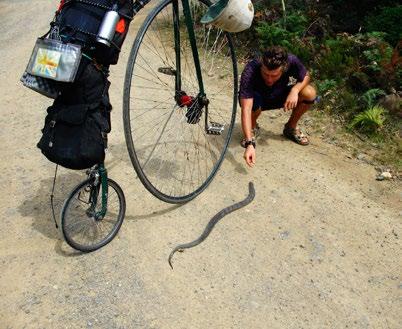
39
Living in the loft above his Victorian workshop in London’s Trinity Buoy Wharf, he leads a spartan existence; making his unique bicycles in an old ships’ cable proving-house and saving his money for his next journey. One of a long line of workshops and studios, there are boxes of herbs on the window ledges and a dilapidated motorbike propped up outside. It’s tucked out of the way and the 19th-century setting seems entirely appropriate. Inside, it’s organised chaos; penny farthings in various stages of assembly hang from the rafters and tools are littered across the work surfaces. I’m offered black tea (all there is) made on the woodstove, and he starts to tell me about his journey and the bikes he builds for a living.
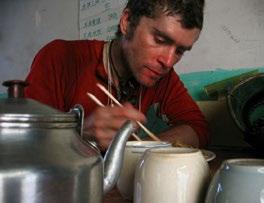
“I built them, broke them and then modified the design until I had something that didn’t break any more,” he says. Coming from a family with roots in classic racing and car manufacture, he was already well-equipped with the engineering skills needed to build his own penny, but had to visit a museum to see how one was actually put together. Now he sells them to customers around the world and his order book continues to grow.
His first attempt at circumnavigation got him as far as Folkestone, before acute knee-pain forced him to abandon the journey. Undeterred, he set out again, and got as far as Budapest, before the same problem stopped him. Some people might take that as a sign that man was not meant to circumnavigate the globe on a large, spoked wheel. Instead, he returned to the UK, sought specialist help, and with special knee-support bands in place, set out on his third attempt. Two and a half years later, and to high acclaim in the national media and cycling press, he returned; largely unscathed.
That first journey - in the cycle-tracks of Thomas Stevens, the Victorian cycling-pioneer - took him through Europe, the Middle East, the Indian Sub-Continent, the Himalayas, China and America. Now he’s planning to tick off the bits he missed, with South America and Africa high on the agenda. “The average day’s journey on a penny is about 40 miles,” he says. “That’s quite low compared to what a modern bike can cover, but there is something about the penny that is addictive.”
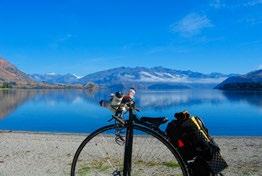
His adventures were many: he had crocodiles in his camp site; he was hit by a lorry; suffered two muggings; and was moved-on by gun-toting soldiers. “Every 18-year-old should be kicked out of the country for a year to learn about the world they live in. We’d have a much better society,” he opines. His outlook on life gives me pause for thought, and I find myself planning a round-theworld trip as we speak.
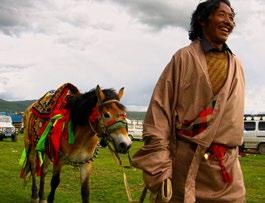

“I built them, broke them and then modified the design until I had something that didn’t break any more.”
40






Even during its heyday in the late 19th century, the penny farthing was known as a notorious killer. There’s a reason that the modern diamond-framed bike was marketed as the ‘safety bicycle’ when it was first introduced: the penny broke necks and impaled people on iron railings. ‘Wheelmen’, as they were known, were the daredevils of their day, akin to today’s freerunners and skateboarders.
Braking is especially inadvisable on a penny, as the rider sits directly over the bicycle’s balance point. As the front wheel slows, the lack of counter-weight from the rear means the rider simply rotates over this fulcrum and does a ‘header’ straight into the ground. As the legs are trapped under the handlebars, there’s fantastic scope for injury. “I’ve broken my wrist four times, my elbows five; my collarbone and my leg,” Summerfield says, “but they’re great bikes.” He did all this while racing his penny against other enthusiasts...
His preferred method of dealing with errant pedestrians and stray dogs is simply to ride them down; it apparently does less damage. Bumps and potholes are equally dangerous, necessitating much dismounting and pushing. Imagine taking such a machine through the high mountain passes of Tibet and the jungles of Cambodia. Thomas Stevens’ account of his circumnavigation (1884-87) is littered with headers, collisions and stretches where he had to get off and push. It’s a wonder either of them made it down the garden path, let alone around the world.
So why on earth attempt long distance touring on such an impractical machine?
For all its danger, the penny farthing has a certain purity of essence that many people find irresistible. It’s the original fixie. There are no gears. There isn’t even a chain. There is nothing to come between the rider and their direct connection to the road. The rider is literally, ‘riding a wheel’. It’s a little like using a quill and home-made iron-gall ink to write a letter. It is simple, elegant, and instead of relying on over-complicated technology to work, it relies on skill. And more than a little bloody-mindedness.

Equipping yourself with a top-of-the-range expedition bike can cost thousands of pounds. They can have hub gears, suspension, computers, dynamos to power your laptop and a whole host of other ‘essentials’. Summerfield went to the opposite extreme and built the simplest of bicycles; and in so doing, proved that guts, determination and a sense of humour are far more important to a round-the-world tour than the latest gizmo.
To cycle around the world takes a certain spirit of adventure and a large degree of fortitude. To do it on a self-built penny farthing takes a certain type of brilliant madness. Overused perhaps, but the phrase, ‘mad dogs and Englishmen’ comes to mind after talking to Joff Summerfield. Well, long may mad dogs and Englishmen venture forth in the noonday sun. The world would be far less fun without them.

43
“Every 18-year-old should be kicked out of the country for a year to learn about the world they live in. We’d have a much better society.”
Words: Mike White.
Pictures / film stills: Lucas Brunelle & Benny Zenga. All rights reserved.

A SPACE THE EYE CANNOT SEE
Lucas Brunelle grew up in sleepy Martha’s Vineyard, USA, enjoying “the kind of childhood that produces psychopaths and career criminals,” riding BMX and getting into trouble. He slid in and out of jail and reform school. Returning home after a spell of detention at 16, he founded his own landscaping business and used the proceeds to buy his first road bike from Cycle Works bike shop. “I hung out at the bike shop on rainy days and ran into a couple of racers who invited me to come with them to the Plymouth Rock Criterium. Seeing this race changed everything for me – the speeds, corners, tactics, aggression and rain all added up to my destiny.”
He started to train, and race, and win. Had sponsorship for a while, but his troublesome side brought him down again – his coach Frank Jennings was busted for coke dealing and Lucas ended up with a two-year suspended sentence for “18 felonies plus numerous other serious offences” including burglary and dangerous driving.
He did his time, pulled himself together, went to college, got a job on Wall Street and then set up an IT business, all the while racing and winning. But Lucas no longer got the same buzz out of riding. “It was like the passion was gone. I did well by taking risks and being aggressive. I often rode tight courses like I was on a BMX bike and dropped riders that were much faster than I was – but for what? Amateur racing is filled with catty dickbag riders who think they’re better than you even if you win the fucking race. I was stuck racing Cat 2, trying to decide what to do. I kept couriering and fixing people’s computers. I went on Critical Mass rides for comic relief and it was in 2001 that I met my friend John McLean, who sported a shoulder camera. Bikes had helped me get out of a self destructive cycle, but it wasn’t until I saw his footage that I finally understood my calling in life.”
That calling has proved to be the development of a unique and frankly terrifying brand of cycle cinematography. He films alleycat races from right in the quickest thick of the action, keeping level with the riders as they hurtle through the busiest cities in the world.
For those that don’t know, alleycat races involve riding at breakneck speed through the traffic, battling to be first to complete a series of checkpoints on a wild-goose chase across the city. There are no fixed routes and few rules. Usually the only rule strictly adhered to is that bikes must have no gears and no brakes. The only way these riders can slow or stop themselves is by locking the fixedgear rear wheel into a skid.
The checkpoint locations are usually issued to riders on a manifest at the start of the race. To add an element of chaos to the proceedings, manifests are often thrown into the air. The riders’ bikes may be strewn at random around them; the first thing to do after you’ve fought for a manifest is to find your bike. Then you’re off, using your wits and your legs to get round the checkpoints fastest. With no fixed route, knowledge of the streets is a big advantage - but following the rider in front offers no guarantee of success.
Imagine you’re in New York city – though it could be London or Berlin or Tokyo or anywhere - you’re riding at lung-burst pace, absolutely flat out. Your brakeless bike sways beneath you in time to your furious cadence. Someone leans down and grabs the wheel arch of a passing cab, enjoying a free ride for a few blocks. Your competitors whoop and holler as they swerve and dart between the tight-packed traffic.
45

“THOSE SPACES, THOSE OPENINGS, THOSE BLIND SPOTS...
THAT'S THE SPACE WE EXIST IN. A SPACE THE EYE CANNOT SEE.”
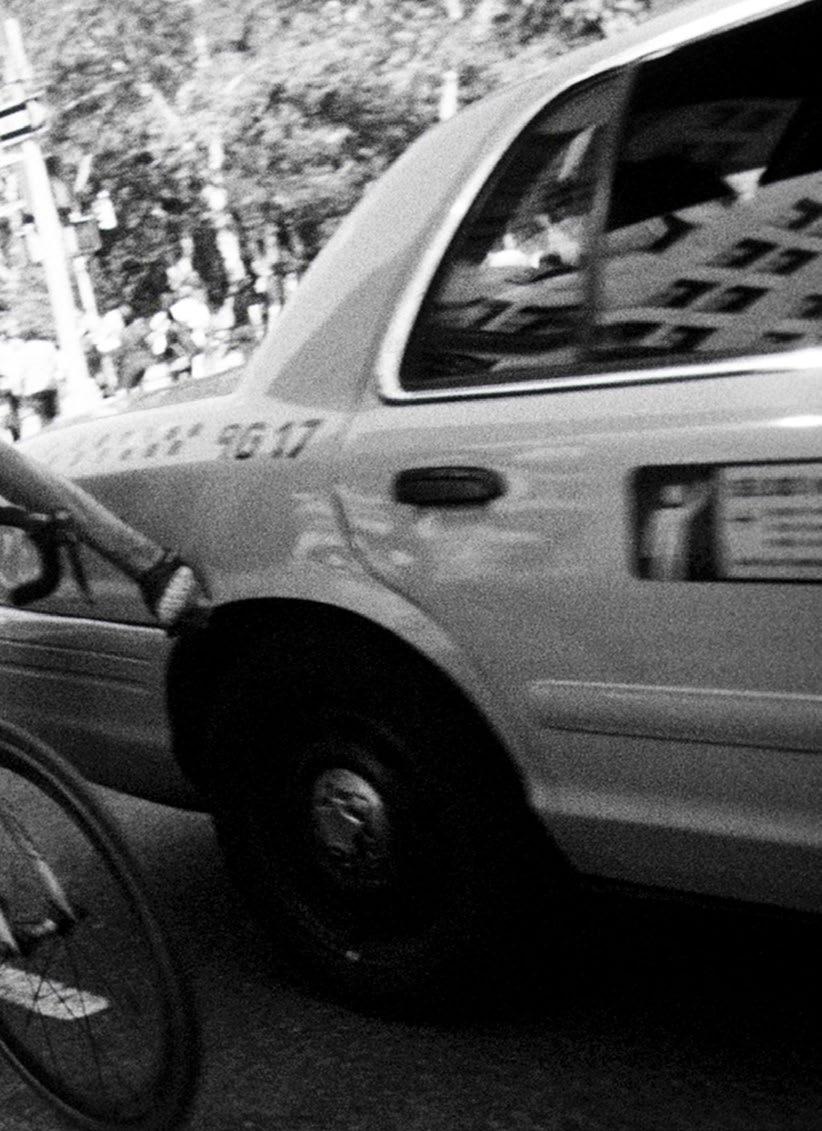

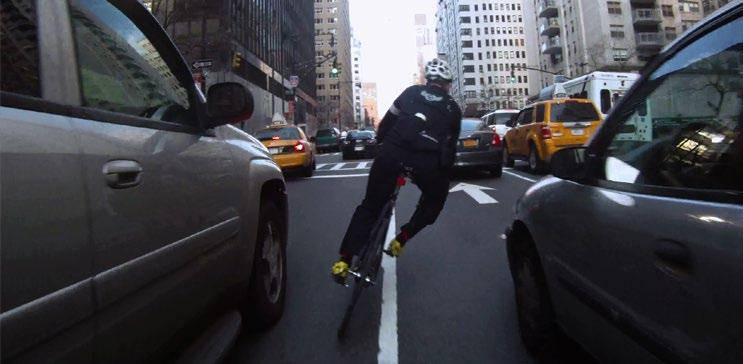



Up ahead, a cross-roads. You barely have time to register the red lights before you’re past them, taxicabs and trucks bearing down on you from all sides. You swerve left behind a bus, then power right, inches from the bull-bars of a pick-up. Horns are blaring wildly. A rider in front tumbles over a station wagon, his bike clattering to the tarmac. But you must push on, lunging and feinting through the snarling traffic, whipping round sleep-walking pedestrians, cutting corners, bouncing down steps, running your fingertips along the side of a bus as it thunders past in the opposite direction.
Lucas Brunelle rides with the very fastest riders in these races, taking even more risks than they do: he has two cameras strapped to his helmet, one pointing forwards, the other back, and even at the busiest intersections he doesn’t look left or right. He relies on steely nerves and a highly developed peripheral vision, keeping his cameras focused on the riders ahead and behind.
These races are controversial to say the least. They’re generally unauthorised and often illegal. The racers’ breathless bravado can scare the general public, catching drivers and pedestrians unawares. In a recent UK TV show sensationalizing the ‘war’ between cyclists and other road users, snippets of Brunelle’s footage were used (out of context, in a highly manipulative way) to highlight just how dangerous and out of control modern cyclists really are. Alleycat racers are often blamed for giving cycling a bad name, for committing all the clichéd crimes – riding on the pavement (sidewalk), jumping red lights, playing fast and loose with the rules of the road.
Those who defend such rides highlight the astonishing skill the riders possess. They make urban traffic look every bit as slow and lumbering and bovine as it is. However crazily they ride, they’ll never be as hazardous to health as the city-choking, obesity-encouraging, motorised traffic they so nimbly negotiate.
Whatever the rights and wrongs of the races themselves, the footage Lucas has collected makes for compelling viewing – as seen in his films Line of Sight and Road Sage, directed and edited by Benny Zenga – a long-term friend of Boneshaker.
Brunelle’s commitment is absolute. For him, riding like this adds a level of hyper-existence to life. It acts as a wakeup call to those who are not living their lives as fully as they could be, to “give them a poke”, “to awaken them … to make them aware of themselves, of their potentiality.”
He follows the races around the world – often the best alleycats form part of the annual Cycle Messenger World Championships, an international competition hosted by a different city each year.
“It’s always the same riders up front, the same riders winning these events,” he says, “because they have that skill... being able to go in a space that the eye cannot see. It’s a place in between cars, in between trucks and buses, taking a certain line through a curb, a corridor, that people just don’t realize is there… we use those spaces, those openings, those opportunities, those blind spots, and that’s the space that we exist in, where we race. There are certain things in life that require total complete focus and this is one of them.”
Lucas Brunelle nowadays is a man of pure focus. After 30 years of racing and 13 of filming, he’s open about his troubled past, using it as a tool to show people that they can “rise above anything”. He doesn’t drink or use drugs. But he does not deal in half-measures; he has a reputation as someone whose commitment to the extreme reaches almost to the point of cliché.
He thrives on calculated risk, speed and chaos, yet he finds a kind of spiritual purity in all this swiftsidestepped danger. The voice-over in his latest project, Road Sage, throws a meditative, transcendent light on the footage, bringing together voices as disparate as Henry Miller, Ben Okri, Allan Kaprow and David Foster Wallace:
“There are totally different ways to think about these kinds of situations – in this traffic, all of these vehicles stuck and idling in my way, you get to decide how you’re going to try to see it. If you really learn how to think, how to pay attention, then you will know you have other options. It will actually be within your power to experience a crowded, hot, slow consumer hell-type situation as not only meaningful but sacred - on fire with the same force that lit the stars. The liberated spirit… not being enslaved by the stupidities or by the rules of the machine of today. The big thing is to keep the flame, keep your own flame going. Take a chance – go nearer to the edge.”
lucasbrunelle.com
49
Papergirl The
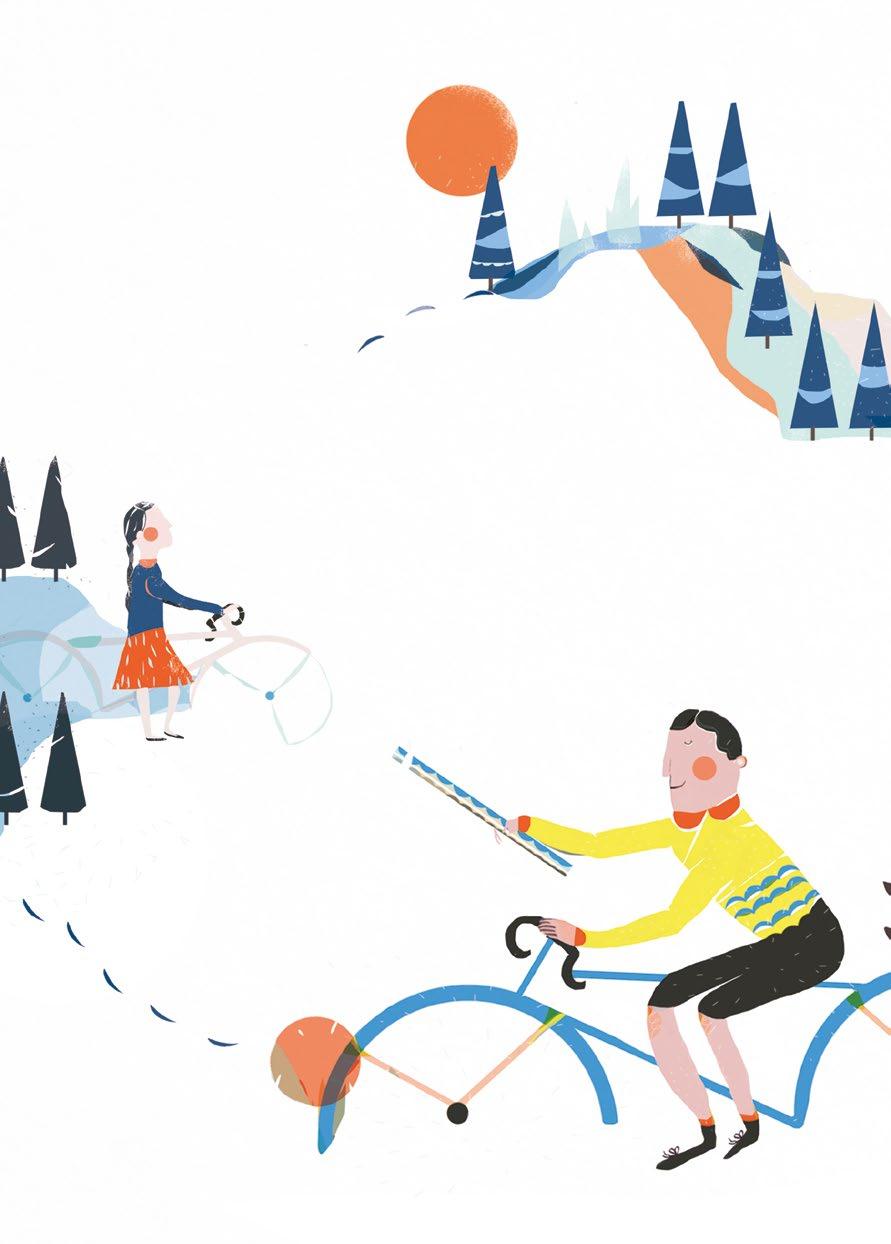
Words: Alex Throssell
Illustrations: Gill Chantler | gillchantler.com

As unassuming as a leisurely group ride around norwich may sound, it was probably the greatest ride of my life
In the space of two months, I met and then lost possibly the most influential person in my recent years.
It was at a battle of the bands gig in late March that I first met Kiama Petit: a friend of a friend and an uncontrollable bundle of positive energy. In the quiet between acts, she raved about local bike-builder Tom Donhou and told me about the Norwich Papergirl ride, her art-meets-bikes end of university project.
By the beginning of May, four weeks after the Papergirl ride, Kiama, still only 21 years old, unexpectedly passed away.
A year and a half later, all of the good things that have happened to me since can, in one way or another, be traced back to that Papergirl bike ride. In fact, it was on that single day that I (almost) met the love of my life, found one of my closest friends and got to know the people at the bike shop I’d go on to work with for the next year or so.
Hindsight is a wonderful thing, but all too often I seem to focus on the negatives. Especially after a long day’s riding, I rarely remember the sunsets, the descents and the the conquered heights, but can far too vividly recall the rain, the wind and the punctures. The more fortunate amongst you might experience the catharsis of having it the other way around, but for me, it’s the grind, the pain, and the frustration that tend to repeat for a long while after. For possibly the only time I can remember before or since, the Papergirl ride was different.
As unassuming as a leisurely group ride around Norwich may sound (and, truth be told, as unassuming as the actual cycling was), looking back it was probably the greatest ride of my life. And although that sounds far fetched, I think that was the point all along. Kiama’s university studies focused on the ‘participatory, analogue, non-commercial and impulsive.’ Her mantra for the Papergirl ride was that art, and the gift that it gives, should be a part of everyone’s daily life, even if it’s just to brighten it for a moment. Some, like me, would experience a fiercer brightness than others.
To pimp our rides a little before the event, Kiama arranged a free-for-all customisation session at a newly opened community bike project. Aided by the project’s founder, Jason, we went about transforming our bikes. Several hours later I rode away with a handcut kaleidoscopic wheel cover, whilst others had attached flags, tassels and flowers. When we left, now considerably more eye-catching than when we arrived, I had no idea I’d return to that workshop in September, shake hands with Jason, and start a new job as a bicycle mechanic.
Although the group was modest - only 21 cyclists in total - it covered a brilliant spectrum. From young girls to old men, to people like me who just wanted to look cool, each carried a custom messenger bag full of carefully wrapped artwork and spread happiness by gifting a random piece of art to whichever passersby we chose. Part of the bunch, but often riding with
me up front, was a similar-minded bike nut who whooped “Free art!” in a range of accents, introduced me to fixed gear riding, suggested we turn an old house into a bike café and became one of my best friends in the process. And just as the Papergirl riders were a rag-tag, happy-go-lucky bunch, so too were the recipients of the random art-gifts. There were curious children, smiling pensioners, surprised exclamations of “and it’s free?”, and one particularly notable bohemian cyclist-type who swerved across two lanes of traffic with reckless abandon at the promise of free art, joyously colliding with a kerb seconds after claiming his prize. Although I didn’t know it then, one of the art gift receivers just so happened to be the girl I would fall in love with – a fact I was to discover on our first date six months later.
Even though it went against the whole spirit of the event, by the end of the ride I’m pretty sure we’d all had an urge to purloin a piece of art ourselves. I know this because over the course of the day several people asked Kiama whether they could take one as a memento. But with the integrity of her project in mind, she politely informed us that we were to give everything away and that we’d hopefully come away with something ourselves as a result. I’d guess that a few probably flouted her advice regardless, but for those like me that dutifully obeyed, Kiama’s words resonated more deeply than she may have intended. And indeed, the gifts that I took from the day were far richer than any piece of art could ever have been.
Cut down by a completely unexpected brain aneurysm, Kiama’s last great act was the spread of happiness to whoever would receive it, all from her trusty sit-upand-beg. And oh, what a wonderful world it would be if we all cycled the same way. It was just one day, and only a few hours on the bike, but I found the love of my life, one of my closest friends, and made memories that will stay with me forever.
In memory of Kiama Petit

52
AS WELL AS SELLING BOTH PRINTED AND DIGITAL VERSIONS OF BONESHAKER MAGAZINE, WE CREATE EXCLUSIVE PRINTS, T-SHIRTS, POSTCARDS & CAPS – ONLY AVAILABLE THROUGH OUR ONLINE SHOP: BONESHAKERMAG.BIGCARTEL.COM
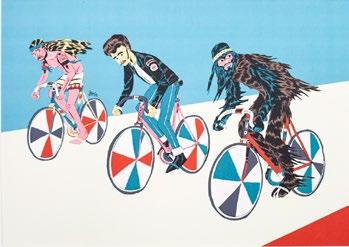
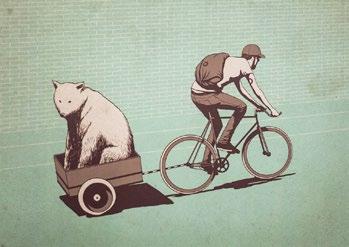

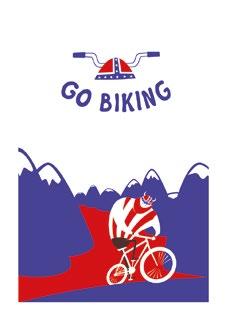




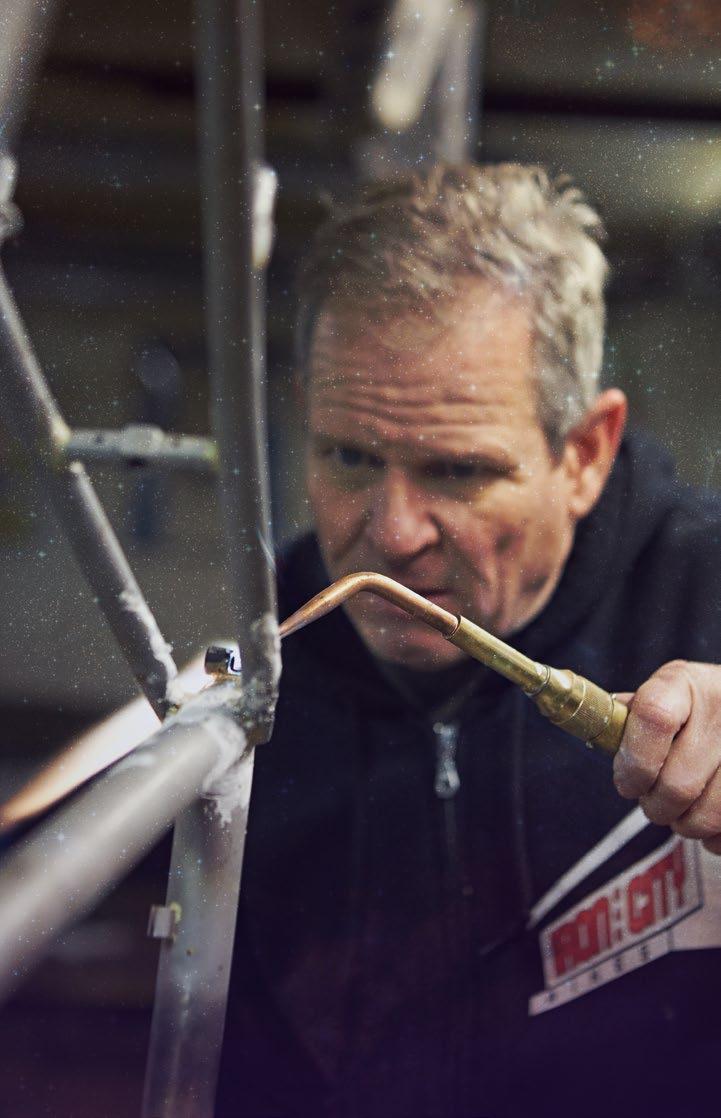 INTERVIEW BY MATT COOK / HELLOMATTCOOK.COM
INTERVIEW BY MATT COOK / HELLOMATTCOOK.COM
 PHOTOS BY DUNCAN ELLIOTT / DUNCANELLIOTT.NET
PHOTOS BY DUNCAN ELLIOTT / DUNCANELLIOTT.NET
Pittsburgh-based Michael Brown doesn’t just build frames for people who love riding bikes, he builds them for people who can’t ride bikes.
Handmade frames have always held a special mystique, the feeling that they can draw out a different kind of ride, different kind of rider.
But inside the Maestro Frameworks workshop this is more than just a feeling. Since 2011 Mike Brown has been welding two extremes of the cycling world together. As well as making mountain bike pioneer Keith Bontrager’s favourite handmade bike, he’s made headlines with builds for riders who usually find it impossible to find a bike that works for them. When he was a boy Mike Brown didn’t especially like bikes. He was active and athletic, but they “just weren’t for him”. He went rock climbing and skateboarding instead, and “spent a lot of time in the ocean”.
And it might have stayed that way if he hadn’t suffered a bad rock climbing fall at the age of 23. The injury kept him on solid ground and encouraged him to
re-evaluate his relationship with the bicycle. What followed was a remarkable transformation. Relocating to Pennsylvania he took up road racing, then steered towards the still fledgling sport of mountain biking. (He’s proud to have been owner of one of the first mountain bikes on the east coast.) He also became more than a little handy with a wrench and eventually opened up his own bike shop. It was here that he acquired his nickname, courtesy of “a gentleman who raced on the Puerto Rican Olympic team”. That gentleman was Edwin Torres, who competed in the 1968 Mexico Olympics. “I built him a set of wheels and he called me the master mechanic. The Maestro.”
And so the Maestro was born. But not too long afterwards, the Maestro went dormant, when Mike took a full time engineering job in the natural gas industry.
Then, in 2009, he quit. “I just wanted something to do,” he says. “So I decided to build bikes.” He makes it sound so simple. (There is, in fact, a beautifully simplistic logic to everything Mike tells me. A kind of undulating rhythm, like cycling in oral form.)
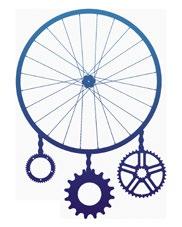
55
As it turns out, actually learning to build bikes isn’t that simple. For a start you need the right teacher. After a long search Mike found his Sensei in Mike Flanigan of Ant Bicycles, one of the original founders of Independent Fabrication. The one-on-one full-time tuition they discussed was still untrialled, and Mike moved from Pittsburgh to Boston to build bikes nonstop for two months. “I’d build ’em, ride ’em and then break ’em,” he says, to study the welds. The price tag for the teaching alone was $30,000. So was it a dilemma to invest that much money? “Yes it was, but at the age of 54, 55 … you have to give it a go. You have to follow your dream, no matter what it might cost.”
Mike set up his workshop in Pittsburgh, equipping it with vintage hardware, including a World War II Nichols Mill (“I think they just work better. I like the way they feel”). After a little practice he began turning out bikes. It wasn’t long before Mike began to attract high praise, most notably from Keith Bontrager who described a Maestro-build as his “favourite handmade bicycle on the market”.
But then something unexpected happened. It started with a visitor, Vince Eberie from Austin, Texas, who had been visiting the Bike Heaven museum just down the road from Mike’s workshop. Vincent’s dwarfism made it impossible to find a bike with geometry that suited him. He was inspired by one he saw in the museum, when somebody there mentioned Mike’s name. He wanted a single speed like his friends, so Mike built him one with 24-inch wheels.
“It was great, to see the smile on his face. And to get the email saying, ‘Hey, I put on 35 miles the other day … I never could do that in my life’, is really cool.”
But it was Mike’s next special project that caught all the news. Ukrainian-born Pittsburgher Mike Trimble has no arms, a birth-defect caused by the Chernobyl nuclear disaster. Adopted by a US couple when he was seven, Mike graduated with a degree in Political Science and now lives independently, but had never been able to ride a bike. He had a bike, a cruiser, which a sports teacher had adapted for him but wasn’t right. Despite approaching a number of other bike shops and builders he had been turned away again and again. And then he found the Maestro.
Where so many others had been nervous, Mike didn’t think twice. In the end, instead of building him a bike, Mike decided the best solution would be to modify Trimble’s existing one.

“My philosophy was ‘let’s give it a go’. The whole idea was to get him on a bike and see how it went, and after that work on improvements. And that’s kind of what the new bike’s going to be. The improvements.”
The new bike that Mike is only now building from scratch will include an eight-speed internal hub and a coaster brake. A friend of his, also an engineer, is working out a way Trimble can gear shift with his stump.

56
PHILOSOPHY WAS ‘LET’S GIVE IT A GO.’”

To watch the footage of Trimble riding on YouTube is a beautiful thing. Something that can rival any Tour de France clip for get-out-and-ride inspiration. It’s no surprise the story got picked up on the news, though how it happened was pure serendipity. Mike B and Mike T were simply cruising around the Pittsburgh Pirates’ baseball field, where the wide, flat sidewalks make for a good first test-ride.
After a little while they realised they were being watched with interest by a couple, also on bikes. The man who eventually introduced himself turned out to be the assistant editor at the Pittsburgh Post-Gazette. The small article Mike was expecting turned out to be a double page spread, which triggered both a flurry of online attention and a flurry of orders from more people, far and wide, who needed his help to saddle up.
San Francisco-based Josselyn Crane has one arm nine inches shorter than the other. She now rides with custom-made Maestro handlebars that allow full piloting control on the left side, afforded by a double-pull handlebar and grip shifter. He’s also in the process of building a rig for a man with one leg eight inches shorter than the other.
Making these dreams come true is, for Mike, quite a lot like dreaming. He spent some time sat on Mike’s cruiser in the workshop, visualising the solution, arms tucked behind his back.
The trick, he says, is re-imagining the bicycle, without corrupting the essence of it. Many people who saw the article on Mike Trimble rang him to say the better solution would have been a three-wheeled recumbent. “But that wasn’t the idea,” he says, incredulous. “Mike wanted to ride a bike!”

Last year Mike received a brown envelope from the City of Pittsburgh and, suspecting a sinister bill, left it on his shelf for some time, afraid to open it. “I thought it was back taxes!” When he finally did, it turned out to be a letter informing him he had been nominated to receive the ‘keys to the city’ (quite an honour) for his work making special bikes.
So if you’re ever in Pittsburgh on 6 December don’t forget to celebrate Michael Brown Day. If it’s not snowing you could go for a ride around the smooth, wide sidewalks that circle the Pirates’ ground. Mike still doesn’t know who nominated him. The list of suspects is probably quite long.

57
“MY
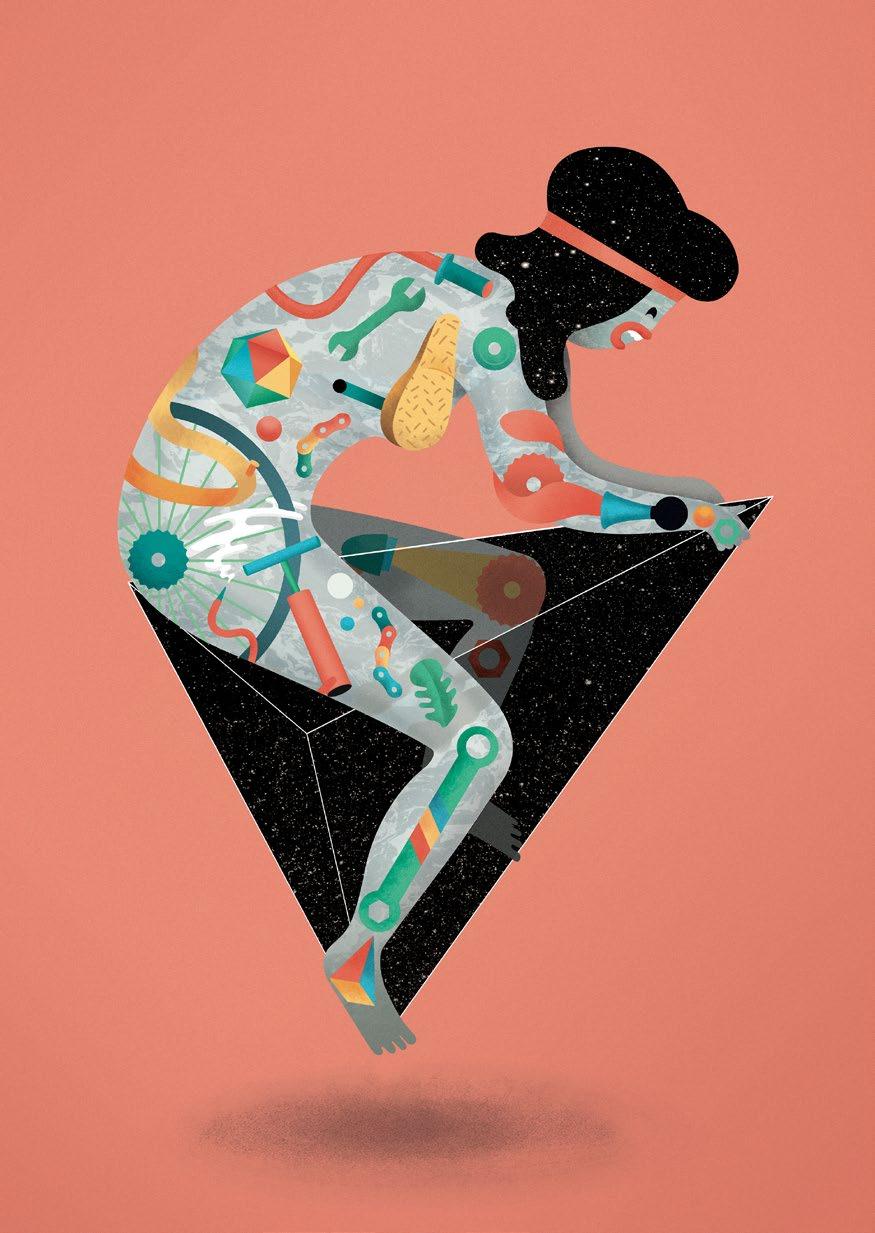


e One thing always leads to another. For Chris Sleath, it all begin with a dream to restore vintage bikes. He began working on classic racing machines from the 1950s and 60s, and needed a way to fund the habit.

Why not create bicycle-related prints, and sell them?, he thought. Although lacking any formal training, he’d always had an interest in design and illustration, so he did a short, self-initiated printmaking course, then began helping out at a printmaker’s. Then, as these things do, the bicycle art began to take over from the bikes themselves. Soon, Chris found that he’d founded Dynamoworks, and was busy producing limited edition typographic screenprint and letterpress posters, all with a cycling theme.
Boneshaker first met Chris at the inaugural Bespoked Bristol Handmade Bicycle Show, back in 2011. We shared a stall, several beers and even more stories with him over that sun-bleached weekend. Talking to him brings the world of printmaking alive, and reveals parallels between it and the world of cycling. “There’s an immediacy, a direct contact between me and the created thing,” he says. He tries wherever possible to work without involving computers, so that “the process is not filtered through a screen, in the same way that travelling by bicycle puts you immediately in touch with the world around you, instead of filtering it through glass. It’s about that heightened awareness, being in
the environment, feeling, seeing, smelling, hearing – all those things that are going on when you’re on a bike.”
e In a past life he’d worked as a scene painter and set carpenter, so the old wooden blocks of letterpress had an immediate appeal. “When you pick up a piece of type, it’s a bit like being a kid again, they’re like the old-fashioned wooden play blocks”, he says. Chris rides in every day along the river to work as a technician at Edinburgh Printmakers, the oldest, biggest open-access print studio in the UK. “It’s a wonderful place,” he says, “a place where anyone can come in and have a go at lots of different kinds of printing.” When he can, he heads

out of the city, up the Tweed Valley to Robert Smail’s Printworks, an atmospheric, National Trust-owned working museum in the Scottish Borders. “I’m very lucky to be able to use it, this amazing old place, full of history, with huge mountains just outside the window. The oldest continually inhabited house in Scotland is just around the corner. It’s all very beautiful.” The printworks was bequeathed to the Trust in the 1980s, but is still set up as it was in the 1940s, when every town used to have a small jobbing printworks, much as many towns used to have their own bike builder. Things changed dramatically in the 1960s, when cheaper,

quicker offset litho printing became the industry standard – and letterpresses were scrapped in their thousands. “They were pushing them out of the windows, selling them for scrap, leaving them to rust in car parks.” Now, much as there is a resurgence in handmade bicycles, there’s a small fire burning anew for traditional printing processes like letterpress. James Lucas, Boneshaker’s beardy founding editor, has also helped establish the Letterpress Collective, another open workshop in Bristol aimed at ‘bringing slumbering presses back to life’. Part of the attraction was a form of creativity that is tactile, rhythmic, immediate. People are always asking Chris “why don’t you do it all digitally?” His answer is simple. “I’m not interested in looking at a computer. I like being hands-on. I like getting dirty. I like doing it this way. It’s a labour of love. Same as I could get the bus to work – but I like riding my bike in instead.”

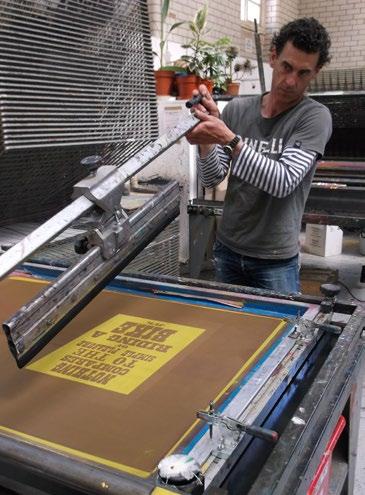
e The prints are designed around memorable cycling quotes. “I’ve read a lot of books about cycling and quite a few of them just jumped out of the page,” he says, despite the fact that “cyclists aren’t particularly well-known for saying insightful or inspiring things because they’re usually interviewed after they’ve just
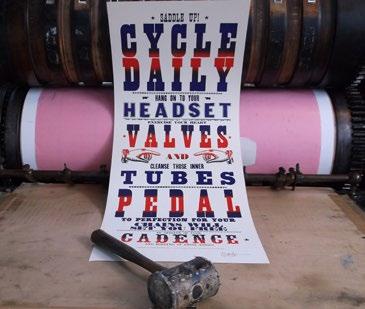


ridden a huge race and they’re completely shattered.” But he’s found some good ones: Italian racing legend Fausto Coppi’s “Age and treachery will overcome youth and skill”, JFK’s “Nothing compares to the simple pleasure of riding a bike” and visionary architect Sir Bertram Clough Williams-Ellis’s “Cherish the past, adorn the present, construct the future”, inked out above a huge spanner.
e Chris begins each print with letterpress, then, for the screenprints, there’s a quick stint on the computer, “just using it as a photocopier really, and then blowing the whole thing up,” in order to prepare the design as a screen,
so that colours can be added. He also creates posters that are pure letterpress from start to finish. “They’re great,” he says, “but they take much longer to do.” But you can tell that this slowness is part of the appeal. “Often when I ride, I ride at a speed that means I can really enjoy the heightened awareness that cycling brings, and when I see something interesting I’ll swerve off down a side road or stop to investigate. I get that with printmaking too; I can go off in different directions, it doesn’t matter if I make mistakes. They’re just happy incidents that can take the work to new and interesting places. It’s a lot like being on a bike, you just set off and let it all unfold...”
e www.dynamoworks.co.uk

Words & Photos: Marko Šajn
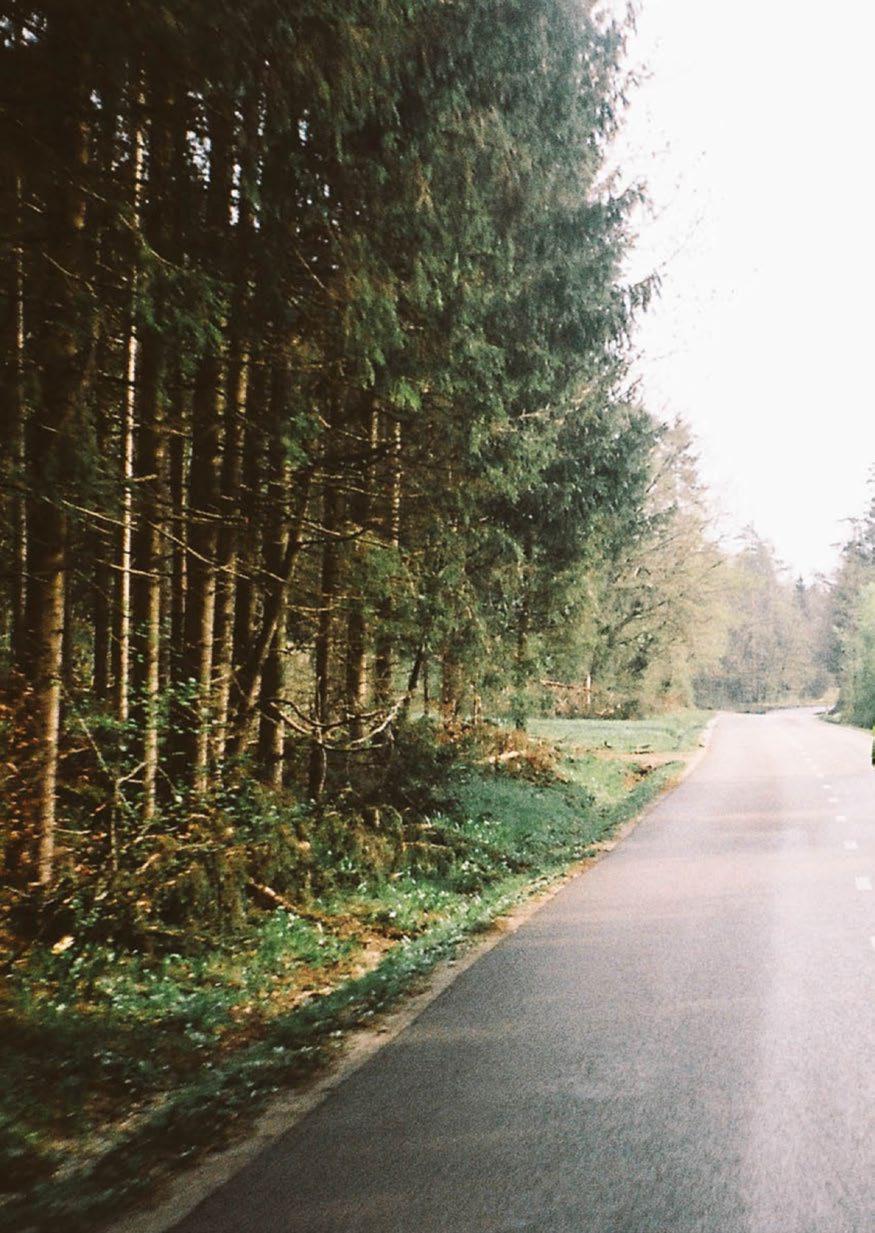

The infamous ‘spring classics’ hold a special place in many a cyclist’s heart. These are tough one-day races like the Tour of Flanders, Liege-Bastogne-Liege and Paris-Roubaix that typically include horrible roads and a lashing from the elements. The ridiculous terrain and bad weather certainly contribute to their masochistic allure, but the major attraction for me is the stories surrounding these fabled rides.
The stories from a hundred years ago when the idea for such races first emerged (usually to promote a local newspaper), the stories of blizzards (like the one that harried San Remo-Milan in 1910) why the start points and routes keep changing (to avoid landslides, or to include a particularly hazardous cobbled descent), and the ones explaining why they didn’t just use normal roads and make it easier (where’s the fun in that?). Cycling is a series of amazing stories written over and over again, and yet we still read and enjoy them. It’s a sport that makes me feel like I know everything and nothing about it at the same time. I see professional cyclists on a TV screen and I can easily imagine being there; everything seems so familiar and natural, but the reality is very different. It’s all planned out: a theatrical drama to benefit the sponsors, a moving billboard orchestra peopled by superhumans.
But like any other orchestra it has to be tuned just right; in order for it to work everyone has to know their place. It’s a constant search for perfection, and if I had to choose one word to describe cycling, it would definitely be ‘perfection’.


The classic races are a true test of this perfection, as teams work hard all year round to ensure they have the best equipment, but it can all go to hell with one unforeseen fault. The riders train all winter only to face the possibility of getting scattered across the cobbles in the first mile, which could ruin a whole year for them. But if it all goes right and the equipment works like it has to, and luck is on the riders’ side, they get to punch the air above the finish line, stagger to the podium and become immortal alongside Merckx, Coppi, Boonen… a dream that any professional rider is willing to risk their life for. I love watching these races because I would like to take part in them one day, too. But I know it’s too late for me to do that on a professional level. So I’ve devised my own way of tasting the grim-faced glory of the spring rides: The Classics Experience.
It’s a project we’ve been organizing for the past few years; through it we try to bring road racing closer to people who started cycling too late to get into it professionally, or the ones who have never been interested in the racing part of cycling at all. Basically, people like me. On the day of a given Classic race, such as Paris-Roubaix, we do a tribute ride. We happen to live near the capital of Slovenia, so that’s where we usually stage them – but the geographical location isn’t want matters.
68
“It’s not a race but it definitely isn’t a tourist ride either”




69
The start, finish and most of the segments of the ride are thematically and technically similar to the original race. Participants are divided into groups and every group takes care of its riders just like they do in the pro peloton. In this way the participants get to experience the thrill of racing and the intense camaraderie that unites the pro tour teams. It’s not a race but it definitely isn’t a tourist ride either.
This project has brought unexpected moments of selfknowledge and vastly deepened my understanding of bike racing, but most importantly, I’ve gained new friends that I know I can rely on when I don’t want to ride alone. For as long as I can remember, cycling has given me a satisfaction unlike anything else, and the fact that I can share that with other people is what gives me the energy to work on projects like the Classics Experience.
If you feel a sense of longing when you realise you’ll never battle the lethal cobbles of the Tour of Flanders or suffer on the inclines of La Doyenne, then stage a Classics Experience of your own. I can’t recommend it highly enough.


theclassicsexperience.com
Things change and things don’t change.


Things change and things don’t change. We’ve worked with New Orleans historian and cyclist Lacar Musgrove across several issues of Boneshaker, and a while back she shared with us a scrapbook created by members of the Louisiana Cycling Club towards the end of the nineteenth century. We couldn’t resist reproducing a few excerpts from this fascinating, crumbling old collection of thoughtful asides, playful poems, caricatures and cameraderie that shows that in more than a century of riding so much has changed – the machines, the clothing, the roads – but the heart of ‘cycledom’ remains reassuringly the same.
 Images courtesy of The Historic New Orleans Collection, acc. no. 98-62-L.
Images courtesy of The Historic New Orleans Collection, acc. no. 98-62-L.
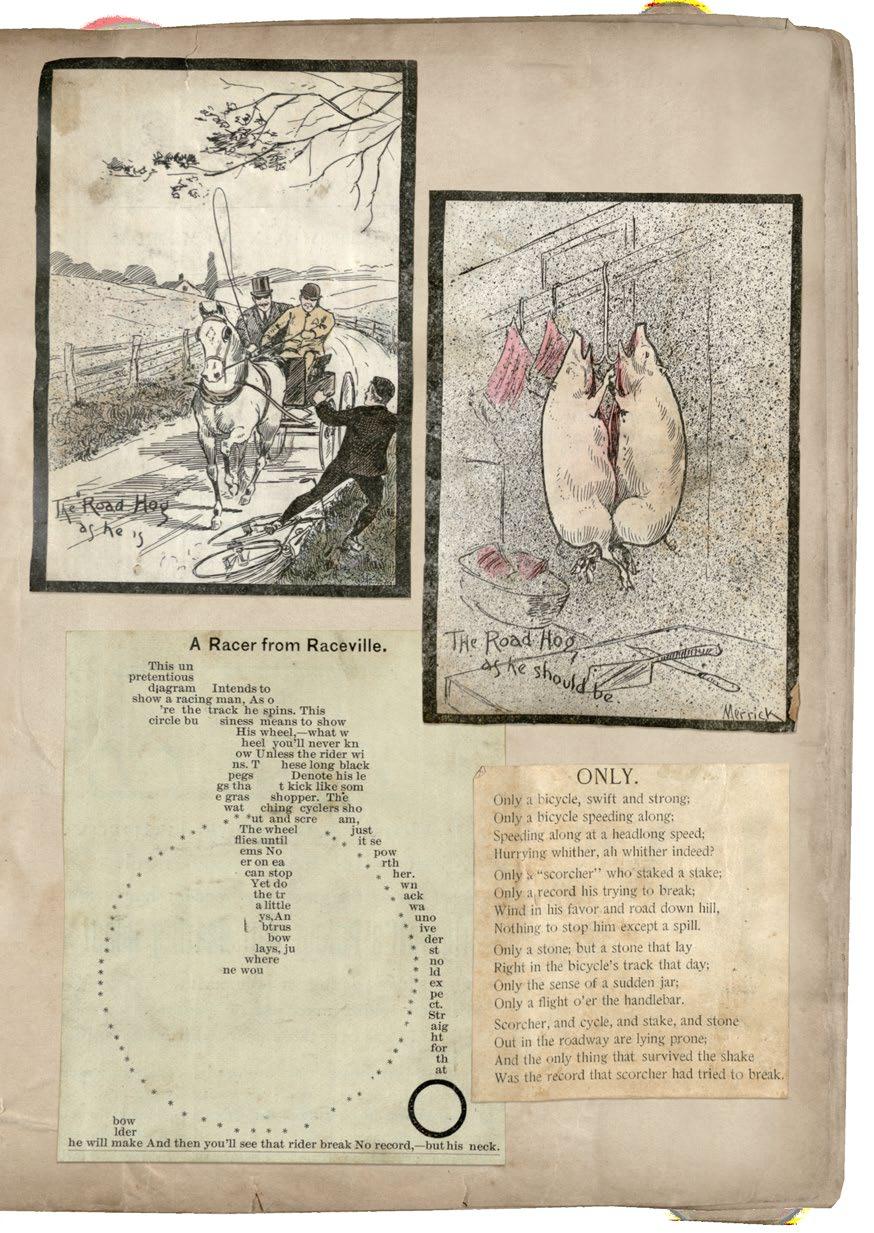




THE TRANSALP
Life at the Back of an Elite Mountain Bike Race

Words: Simon Lay
Images: Simon Lay & Sportograf
Last year I rode the TransAlp mountain bike race: 8 days, 675km and over 20,000m of climbing through Germany, Austria and Italy.
I am not, however, an elite mountain biker. I am an overweight, middle-aged bloke with a dodgy knee who clung to the tail of this amazing race with my race partner who, prior to signing up in a drunken bet, hadn’t ridden a bike for 10 years. And he has IBS.
Our story is the tale of life at the back. Trying to make the cut every day, being able to say that “we did it”, our only victory being over those who fell by the wayside due to injury or mechanical failure.
Football fans can play football in the park, but they cannot take a shot on goal at Wembley; cricket fans don’t get to pad up and walk out onto the pitch at Lords. I’ve always thought that one of the joys of cycling is that you can ride the exact same routes as professionals. Not to try to put yourself on a par with the pros, but to say that you have some understanding of their trials, perhaps. That is what the TransAlp was for me, a chance to ride not just the same route as professional riders, but to ‘compete’, to ride not at my own pace, but the pace dictated by cut-offs and a dreaded broom wagon. For me, it was an inspiration, an opportunity to test myself in a way that daily life simply doesn’t. I want to pass on that sensation to others and to tell them “yes, you can”.
The absence of a need for road closures or specialist courses in cross country mountain biking means that time cut-offs are more generous off-road compared to on-road, so you can sign up to an official UCI race with no licence, no team and an off-the-shelf bike. Armed with little more than an ironic cycling top and a handful of cereal bars from your local supermarket you can put yourself on the starting grid alongside cycling legends. You don’t just get to ride the same route, you get to compete, on a level playing field and under the same rules, against the very best.
So it was that in July 2013, I found myself in the middle of 1200 eager riders in Mittenwald on the German border with Austria, a number board cable-tied to my bike. With a “woo-hoo!” from Blur’s Song 2 we headed over the start line of the TransAlp, an elite, mountain biking stage race which attracts over 30,000 spectators and at over 650km long with more than 20,000m of climbing is regarded as one of the toughest events in Europe.
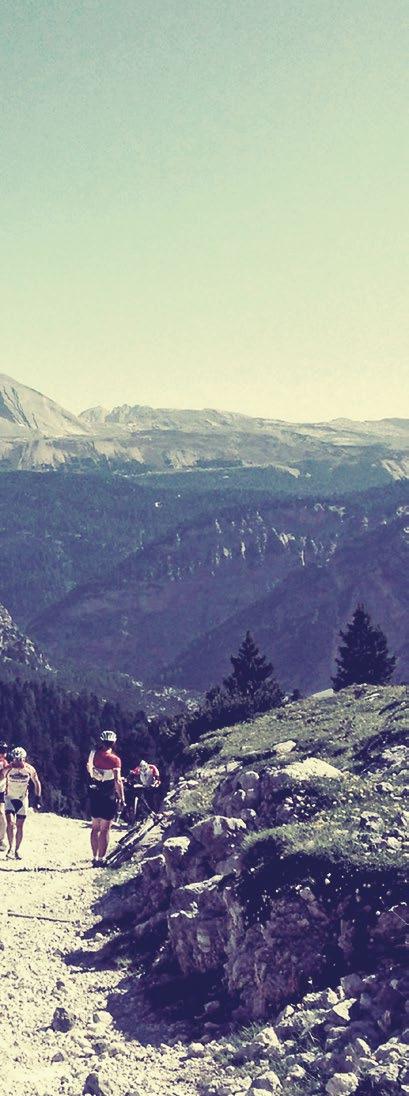
79
Ahead of me were professional riders. Everyone rode in pairs but the pro-teams were typically fielding 6–10 bikes, just to add to the intimidation. These racing machines would finish each day before my partner and I had passed the mid-point feed station. Some mornings you would see them, barely able to walk across the hotel foyer on ruined legs before the ritual of a 60-minute spin-up on a turbo-trainer loosened the muscles enough to enable them to complete another 130km stage with average speeds of over 25kmph, despite 3000m of climb.
The decision to enter the TransAlp came about because I wanted a challenge to focus me after a knee operation. My partner signed up for the classic reason; a drunken bet. With only seven months to attempt to turn an overweight 40-something and a 30-a-day smoking IBS sufferer with no mountain biking experience into elite mountain bike riders, we trained almost every weekend through winter and spring. Gradually we increased our mileage, but we never came close to the daily climbing totals that the Alps would impose. Living in the UK where the longest continuous road climb is 8km and rises just 272m, it is hard to prepare your body or mind for the 34km of continuous climb up 1900m from the start at Mayrhofen to the Italian border at the top of Pfitzcherjoch on Day 2 - or the 22km long, 1800m slog from Brixen up to Lüsener Scharte on Day 3 of the TransAlp.

Stage racing for the first time is scary and it is an event format that barely exists in the UK. Fitting training around work and family life, the best you can do is a two or three day ride. We rode the South Downs Way, the Trans Cambrian Trail and countless loops in the Peak District. Sometimes we’d ridden in snow and carried our bikes, many mornings we’d ridden in darkness on extended commutes through sleet and rain. We thought we’d trained well, but we’d never tried to smash our legs for eight consecutive days. We really had no idea what it would be like after four or five days of riding for eight or nine hours.
At some point, we realised that the word ‘only’ took on a new, curious definition. As in ‘it’s only 85 km tomorrow’ or ‘we should only need seven hours that day’. After reaching Alleghe on Day 4, time became almost without meaning for the first two thirds of each remaining stage: I realised I might be four or five hours into the day and have barely noticed more than a few minutes of that time.
Often designed as ski-runs, the trails through Austria and into Italy regularly have no flat sections at all. This is something a UK rider is totally unprepared for. In the UK you know that round a corner the trail will flatten, a meagre respite to let you catch your breath. This does not happen in the Alps. Every day, at some point, we would have to fight the urge to give up. But then, at that very point of total exhaustion, we would crest a pass and laid out before us would be another stunning Alpine vista with a slim line of singletrack dropping down across a lush meadow and disappearing temptingly into the forest far below. Sometimes the views were staggering in their composition in a way that reconfirmed how far we had ridden, like atop Monte Grappa on Day 5 where we emerged from the edge of the Dolomites to be rewarded with a view out across the Treviso plain to the Adriatic coast, Venice shimmering on the horizon.
And anyone can do this. You pay your money, you book your flights and you can ride these amazing trails. You don’t have to be famous or a super-human pedalling machine to be cheered on by crowds. It doesn’t matter whether you are racing for first place or just racing against that person in front of you for 527th position. The red mist still comes down to make you reach deep into your soul to find a reason to keep climbing, or to banish fear to the edge of your mind as you fly into the dust cloud down a 30km long rock and gravel trail at 50 kph. You do not have to be a professional to do this, you just need to have the heart and determination to beat the broom wagon each day.
"YOU DON'T HAVE TO BE A PROFESSIONAL TO DO THIS, YOU JUST NEED TO HAVE THE HEART AND DETERMINATION TO BEAT THE BROOM WAGON EACH DAY."
Having completed the TransAlp, picked up my finishers shirt, a medal and a free beer on the shores of Lake Garda, I reflected on the fact that the chance to compete against professional cyclists had taken me to the TransAlp. “Forget Strava”, we had said, “put a number on it and see where you really stand”. Not quite the Lanterne Rouge of last place for us, but we had only hung onto the tail of the event by the skin of our teeth. That may not sound too special, as achievements go, but in an event where hundreds can fail to finish, just making the cut each day was the goal we had set and achieved. We came perilously close to failing on Day 4 (St Vigil) when we were nearly caught by the sweeper team that collect the trail markers behind the race. We’d ridden away

downhill from them with absolute abandonment before skidding to a halt, the way blocked to allow a helicopter to pluck a broken rider from the forest trail. The misfortune of that rider was our lucky chance. The few minutes we were late crossing the line that night in Alleghe were reset to allow for the imposed safety delay and we kept a clean sheet.
I now know that I have neither the talent nor the ability to hurt myself in the way that only a professional mountain bike rider can. As a sign of respect for professional athletes I could never call myself an elite mountain bike racer. But I did earn the right to call myself an elite mountain bike race rider and that will do for me.
BALK AN RIDE
On an early morning in August 2013, we lined up with our bikes in a sun-drenched street in Budapest. Few of us had spent time together on a bike before, some had never even met before. And until that morning one of us had never even ridden more than 60km.
But there we stood, with nearly 1700km of riding ahead of us, and little more than a week to do it.
Thirteen different characters, unified by a love of cycling and the will to cross the Balkans on fixed gear bikes. Through Hungary, Serbia, Bulgaria, Greece and finally Istanbul and Turkey, right up to the border of our continent.

It all began in 2012 with a ride from Munich to lake Bodensee, to meet some friends from Stuttgart and circle the lake on a sunny weekend. Surprisingly, three guys from Hamburg had mixed with them and after two days of riding and having fun we felt that 300 kilometers was not enough. In the end, we rode more than a thousand; from Milan to Barcelona, fixed, with racks and panniers, sleeping on beaches and traffic islands. After that, everybody knew that this was just the beginning.
We started with a beautiful ride alongside the river Donau. Half of us were riding brakeless, which led to some exciting moments when sudden obstacles appeared, such as stray dogs bursting out of the undergrowth. Just as we were getting used to the dogs and making headway, a deep pothole destroyed all vague dreams of a perfect day one - skidding, a leg in the air, a sudden crash. The front rider had forgotten to warn the rest. Clenched teeth; a wounded hand barely out of plaster. We nursed our injuries with a long soak in the warm waters of the river Donau later that night. Our first night’s shelter was the backyard of A Müheli’s, a lovely bike shop in Szeged. That first night under the stars we made contact with the most aggressive mosquito species known to man, highly skilled in precisely spotting any non-protected millimeter of bare skin, and impervious to the several layers of absolutely useless expensive mosquito repellent. Within minutes we had been all but drained of blood.
All we’d learned about cycling in Serbia so far was that Belgrade’s cycling clubs stage their championships indoors on rollers because it is too dangerous to attempt them outside. Promising.
On our way to Belgrade we somehow split into two groups and lost each other. Now, a rule we’d set at the beginning of the tour
82
Words, Photos & Sketchbooks by Raphael Krome
Few of us had spent time together on a bike before, some had never even met before.
And until that morning one of us had never even ridden more than 60km.

(because it had worked on our 2012 excursions) proved to be wise: follow the route, no matter what! That might not sound too adventurous, but considering our route was devised on Google maps by connecting scenically promising stages and exciting cities while roughly avoiding big highways, believe me: it is.
A fully lit up football field in the middle of nowhere was the stage for our sudden and unexpected reunion. The group that had ridden ahead had been forced to a standstill by punctures. Without a pump between them, they had enjoyed a long walk to the football field. Just a few kilometers later we were given the chance to celebrate that unexpected reunion – a crazy Serb waved a bottle of Jack Daniels out of a little café on the darkened village road and shouted: “Come on! Drink with us!” – and sure we took that chance.
Barely fifteen minutes and half a dozen ‘one more, why nots’ later, some of us were doing joyrides in the crazy Serb’s car. We were wasted. Breaking loose was hard and some Serbs followed us, long after we’d left the village behind, doing wheelies on their superbikes.



50 kilometers later and a little closer to sober again we entered Belgrade, followed the biggest neon ‘hotel’ sign we could see and before anyone could even express his feelings on the idea, we found ourselves in fully Bang & Olufsen-equipped luxury apartments with rainforest showers, eating falafel on our expansive balconies.
The kind hotel owner loved the story of our journey to Belgrade and gave us some really special rates. The next day came as they always do, and we had to leave amazing Serbia and the crazy Serbs.
We met the first Bulgarian hills, leading to some intense tunnel rides - the local lorry drivers have their very own definition of safety-clearance.
Escaping onto a parallel cobbled road led us directly into a Roma ghost village with a big factory ruin.
Spotting an American flag on its roof, we approached curiously, coming to a sudden stop when we met a Spanish-speaking military guy who advised us to turn around NOW and immediately leave the area. Welcome to no-mans-land.
For the first time during our trip we could feel vibes of depression in the villages we passed. Everything was rather shuttered, compared to Serbia or Hungary. It was hard to believe that Bulgaria is a member of the European Union. The monstrous apartment blocks of Sofia, with junkyards in between functioning as playgrounds underlined this impression.
After Sofia, the mountains got higher. We crossed four, more than 3,000 meters high, over a distance of 230 kilometers.
84
A Spanish-speaking military guy advised us to turn around NOW and immediately leave the area. Welcome to no-mans-land.
We circumnavigated a huge, upland reservoir with clear, turquoise water, fantastic views after every bend. The riding was so demanding, so satisfying. Cold, wayside mountain spring water every few miles helped to cool our heads.
Our daily energy supply was always at hand. There were fresh figs, plums and grapes growing wild along the road. But promising alternatives serving local specialties were always welcome - the most memorable being the ‘Cantina’, little more than a roadside shack. Hungry and thirsty as always, we were served a simple meal of spicy, grilled meat with roasted tomatoes and onions, prepared by a wonderful old man who told us that we had just eaten all his supplies for an entire day, as he never stored ingredients for more than 15 meals because otherwise the shed would get robbed by night!
And this was just one example out of so many stories on our tour that showed the boundless hospitality, kindness and joie de vivre of the inhabitants of the Balkans. It is hard to describe what you feel when you are utterly thirsty, and you discover a little shed in the middle of nowhere where an old farmer selling watermelons for 80 cents a piece rejects your money, smiles and nods.

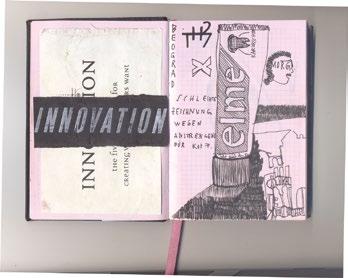

In the slipstream of a herd of sheep, we passed the Greek border.
Arriving at the tourist town of Orestiade we had to ask ourselves: who on earth chooses this city for vacation? Loads of tourists and tourist-shops, ultra hot, no sea, no beach, no nothing. Instead, soldiers and camouflaged vehicles passed us on a regular basis.
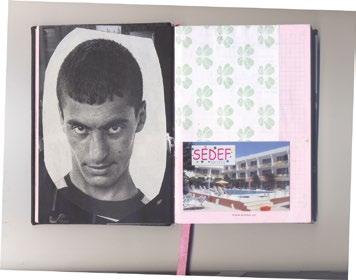
85
The Turkish border seemed to be close.
There are only two checkpoints between Greece and Turkey and with loads of kilometers still to go to the border, we were already passing watchtowers and parked armadas of old tanks, being maintained for eventual use. The atmosphere was tense.
One of us had lost his passport in Sofia. At the Greek border, thanks to some tourists being able to speak some German, the border officials turned a blind eye to the scrap of paper our guy had gotten at the German embassy in Sofia. We were lucky that time. But when approaching the Turkish border, flanked by dozens of national flags, the armed troops immediately put our debating about the right tactics for our passport-less guy to bed. We had entered the zone in between the countries. After some irrelevant back and forth with a supervisor guy, our man was escorted into the police station. The police officers took their own sweet time to decide his destiny, but this time, we were fucked. He had to take the bus back to the German embassy in Thessaloniki to get proper travel documents. Darkness was already falling and riding circles in front of the police station couldn’t protect us any more from armadas of Balkan mosquitoes so we decided to move on.
Downhearted by the border experience, it was a calm and hard ride, accompanied by muezzins singing throughout the night, even in the remotest and darkest areas we crossed. I won’t forget the feeling of that night ride.
Fresh tarmac had been kind of an exceptional thing for quite some time so a long descent on super fresh tarmac raised the mood of the whole team by 100%. We felt that we must be very close to the coast: could we really taste salty air? Then, after another demanding gravel climb through dark fields, fleeing some wild dogs in a village, the sun emerged out of the ocean right in front of us. We came to a stop to relish the moment. Overwhelmed by the beauty of that moment, by and by some of us fell asleep right there on the warm tarmac. The rest watched the spectacle from the comfort of a roadside ditch, and let their minds wander to the horizon, to Istanbul.
Spending the night in the Turkish ‘tourist paradise’ of Sarköy felt strange. Prices for a hotel room varied according to the number of visible tattoos of the person asking, and for the first time on our tour we didn’t feel welcome. The bizarre presence of huge national flags on every square and on exterior walls added to this uneasy feeling. We realised that we had entered a very different culture.

Meeting at 4 o’clock in the morning to hit the road to Istanbul, no one shed a tear for Sarköy.
Harsh and salty head- and side-winds bid us welcome on the curvy coastal road.
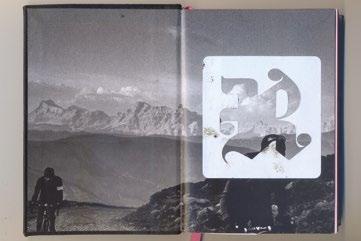
But another spectacular sunrise revealed a lunar-scape with serpentine roads leading us into a vast coastal mountain-chain, climb by climb.
The asphalt hairpins were followed by rough and steep gravel ones, and in combination with the continuing winds, these were by far the most intense climbs of the whole tour.
Overwhelmed by the beauty of that moment, by and by some of us fell asleep right there on the warm tarmac.
No less intense was the scary downhill ride into a small fishing village that followed – so steep that we even got faster while skidding! I still wonder how our tires survived. After ensuring that all legs were still in place we devoured everything a flying Börek-seller had, and drank some of his self-made brandy to calm our nerves after that breakneck descent.
We entered civilization again in the form of a two-lane highway filled with potholes too deep for any road bike tyre and without any kind of road markings. Together with the fucking headwind making everyone stand still if they took power off the pedals for three seconds, it was a complete nightmare; we were on our last legs. Too exhausted even to be angry about the 40-tonners rushing past us with inches to spare, we stopped at nearly every gas station to flee the crazy traffic, like they were some kind of sacred haven of recovery. Reaching Istanbul seemed impossible.

When night fell, we chose a longer, parallel route in the hope of meeting less traffic, but we ended up in a Turkish wedding which completely blocked the street, with dozens of people dancing to live music and celebrating.
We had no choice but to get ourselves into this party. We were well received by the celebrating crowd and served fruit juices before we could say ‘hello’ and dance our way through!
With another 30 kilometers to go, despite several people we asked claiming that we were already in Istanbul, we decided to take the short cut and return to the highway – which meant taking a night-ride on a four lane inner-city highway. Filled to the brim with adrenaline and with all the motorists staring, weaving or honking at us - even the police just looked on and smiled - we flew directly into the heart of the city and only stopped when we reached Taksim Square.
We had set out as near strangers, but we arrived as soul mates. I can’t wait to reunite with the boys and hit the road again. With those guys, you never know what might happen in the next ten seconds. What better recipe is there for adventure?
raphaelkrome.com / zeitrapha.tumblr.com
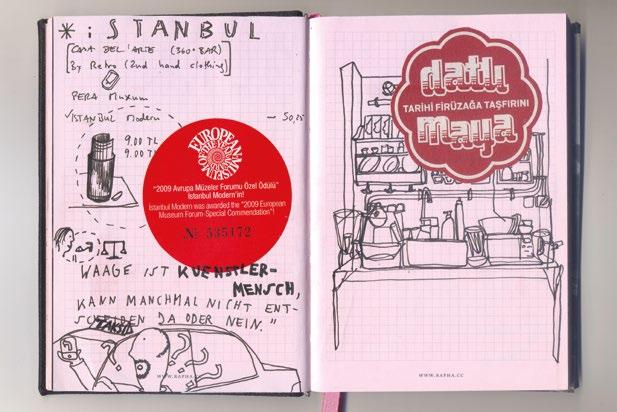
87

A journey inside the legendary Reynolds
 Photography by Chris Lanaway christoperlanaway.4ormat.com
frame
Photography by Chris Lanaway christoperlanaway.4ormat.com
frame
s the samurai sword glides cleanly through your neck, it’s unlikely that your last thoughts will be of the meticulous folding and layering of steel that went into the blade’s manufacture. With any luck, the tangled whirl of your brief existence will flicker through your fading consciousness as carotid claret sprays luridly all around. But sword aficionados – especially those whose lives depended on their blades – had a keen interest in steel and its structural qualities. The men who made those blades became legends.
As you glide cleanly through the rush hour traffic, it’s similarly unlikely that your mind will dwell upon the processes that resulted in your bike’s frame behaving as it does. But bike aficionados give a great deal of thought (and money) when choosing a frame material. The varying qualities of different metals – stiff, superlight carbon, imperious titanium, lively steel – all give a different ‘feel’ to the ride, and bring their own distinct characteristics.
And of the men and women who make these frames, many are now legends. When it comes to steel, one name stands out: Reynolds.
But it is not frames themselves for which Reynolds are most famous, but the simple steel tubing needed to construct them. Their slender, elegant tubes have carried the winners of 27 Tours de France and made the company a household name around the world.
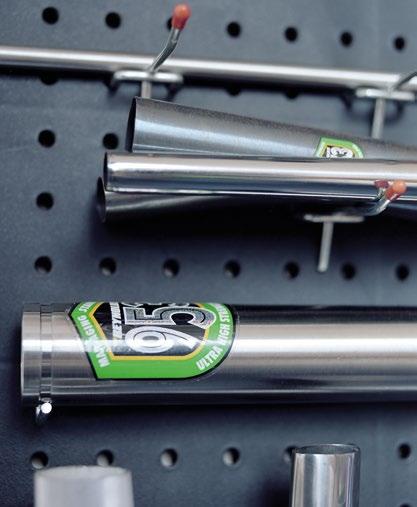
It all began with nails. John Reynolds – the man who started it all – was born the same year as the Battle of Waterloo (that’s 1815, fact fans). At 26, in 1841, he founded a company producing ‘cut’ nails – nails stamped out from rolled iron. The company became very skilled at powered metalworking processes. Years passed, the business thrived, and when the bicycle boom of the 1890s began exciting industrialists across Britain, John’s grandson Alfred turned his mind to the possibilities of manufacturing seamless steel cycle tubing, and, more importantly, to overcoming a problem which was troubling the bicycle builders of the time – how to overcome the weaknesses caused by joining thin tubes to relatively heavy lugs. Before long, Alfred had cracked it, devising a means of manufacturing tubes whose wall thickness increased at the ends only, without increasing the outside diameter, giving the cycle builder the much needed extra strength at the joints and eliminating the necessity of inserting a liner into each end of a tube, which, until then, had been the only means of achieving this.

90
A



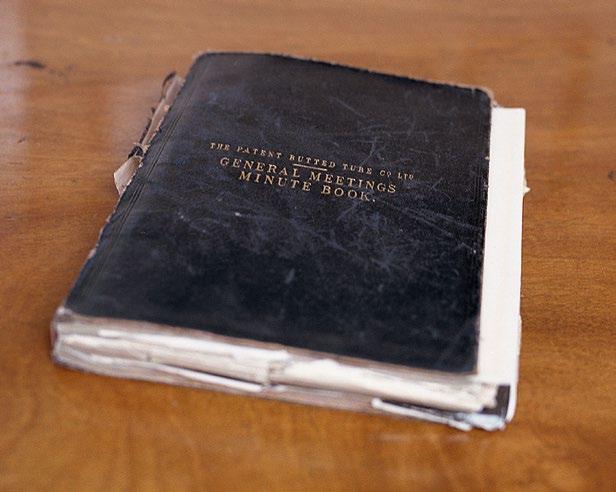
91
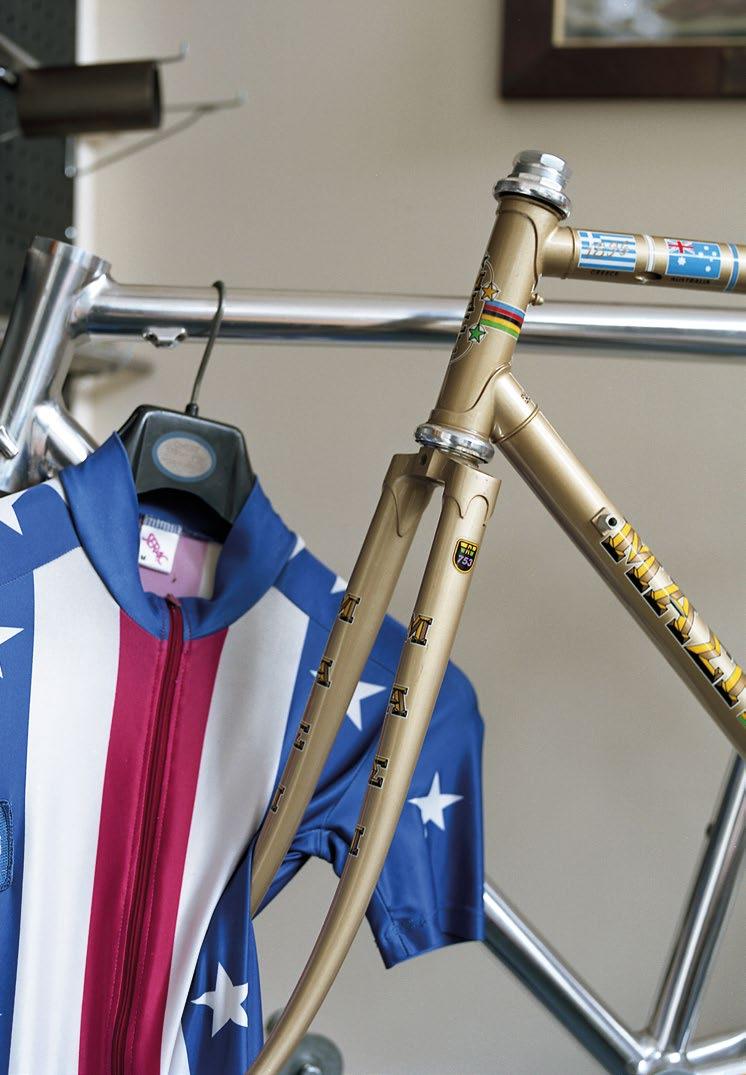
92
In 1898, the Reynolds Tube Company was officially founded and it has remained at the forefront of bicycle production ever since – barring a few years during the two world wars, when work for the war effort took over. This led into tubing for aviation, and the ongoing quest for lighter, stronger tubes – a quest which bore fruit in 1935 in the form of the now world-famous Reynolds 531. The ‘5,3,1’ figures are the ratio of the three main elements in the steel’s chemical composition. Now you know.
Reynolds as a business has diversified and grown into many areas of engineering, embracing new materials including titanium, aluminium and carbon fibre. They’ve been called upon on to make all sorts of things, from Spitfire wing struts to flamethrower parts and even the oxygen tanks used by Edmund Hillary when he conquered Everest. One of these original tanks ended up being used as a gong, calling the Lamas to prayer at the monastery of Thyangvoche at Khumvu, high in the Himalayas. What a strange journey Reynolds steel has made from those first cut nails of 1841.
The bicycle tubing’s a tiny part of what Reynolds do now, but to cyclists there will always be something reassuring about those familiar green and gold labels bearing the legend ‘531’, ‘753’ or, if you’re very lucky, ‘953’.
When photographer Chris Lanaway went to visit the hallowed Reynolds production plant in Birmingham, he was struck by the “industrial aroma”, the orderly arrangement of machines and men, the prevailing sense of calm efficiency. Through a door painted in Reynolds’ signature livery, two old prototype frames by British bicycle builders hang proudly above the vast machine that draws each tube to a specified diameter.
Tucked away in the corner lies what Chris describes as “some form of torture chamber”, a large machine “encased in a steel container which when fired up unleashes repeated banging that resembles a mid-summer thunder storm rumbling through the factory floor”. This machine produces fork blades and oval-shaped tubes by a cold forging process which forces the metal into shape.
Once finished, each tube set is meticulously inspected and carefully boxed up; a selection of boxes sit neatly beside the inspection area labelled with the names of individual frame builders awaiting their delivery.
It may be 20 years since steel left the pro peloton, but it continues to fuel the growing cottage industry that is bespoke frame building. The number of independent frame builders has seen a happy resurgence in recent years, as more cyclists opt for characterful, custommade steel over mass-produced aluminium and carbon frame sets. Earlier this year the Madison-Genesis cycling team announced that their riders would be competing on 953-built bikes, saying “in 953, Reynolds have a steel tubeset to trump Titanium, clawing back some much needed, long-lost ground to the favoured modern materials – stainless, stiff, competitively light yet still retaining that unmistakable compliant and roadconnected ride feel for which steel is famous.”
More than a century after the release of the first double butted tube, steel remains the stuff of legend.
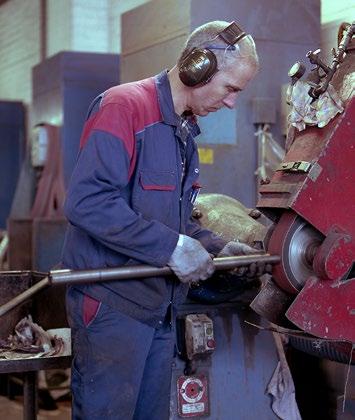
93
More than a century after the release of the first double butted tube, steel remains the stuff of legend.
words Jet McDonald / jetmcdonald.com
illustration Matias Fiori / re-robot.com
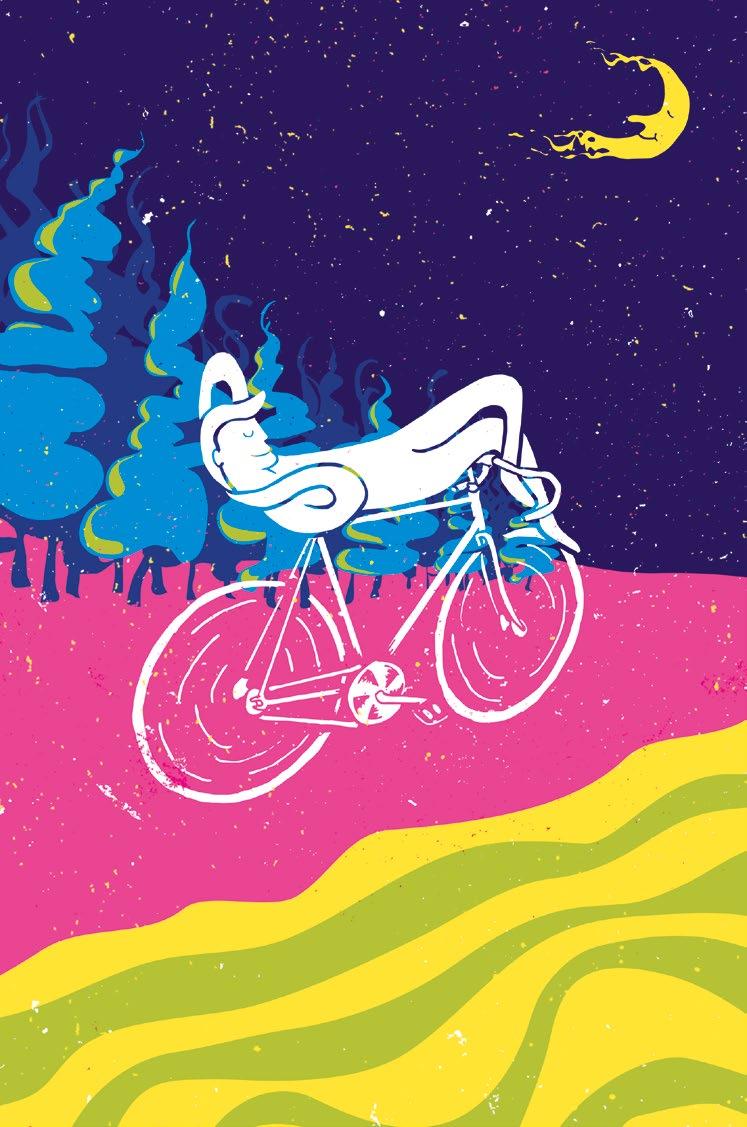
The first TheTrip first Trip
On April 16th 1943 the organic chemist Albert Hoffman noticed a “not unpleasant intoxicated condition” whilst purifying Lysergic Acid Diethylmide 25, a compound derived from ergot, the fungus that grows on Rye grass. He worked in a pharmaceutical lab in Switzerland where, during the war, fuel was hard to come by and car travel a rarity so when, three days later, he deliberately “dropped” 250 micrograms of the drug, and experienced, according to his lab journal “anxiety, disturbed vision, paralysis, urge to laugh” he clambered on his bicycle and rode home.
Thus it was that the discoverer of LSD took the first ever “trip” on two wheels.
“Everything in my field of vision wavered,” he said, “and was distorted as seen in a curved mirror. I also had the sensation of being unable to move from the spot,” even though his lab assistant, a young woman called Susi Ramstein, had to pedal furiously to keep up.
At home the bemused family doctor proclaimed Hoffman physically fit, if somewhat deranged, and it was only then that the chemist began to relax into his experiences. “A kaleidoscopic flood of fantastic images dazzled me; they circled and spiralled, opened and closed… [and] for each sound there was a corresponding, vividly shifting form and colour.” Later, after rest, he discovered “a feeling of extraordinary well-being… outside, the garden was still damp from a spring rain, and the sun made everything sparkle and gleam in fresh light.”
Hoffman’s experiences were the hallmarks of a classic acid “trip”; a stimulation and distortion of perception, dissolution of the boundaries between the internal and external world and, at the right dose in the right setting, a mystical union with the natural world.
April 19th was later christened “Bicycle Day” by Thomas B. Roberts, a professor of psychology, and when Hoffman asked why he had used the image of the bicycle Roberts replied “the bicycle was a more concrete image than a chemical structure, and in America there is a famous poem that marks the start of our revolution in 1775…
‘Twas the eighteenth of April in ‘75 And hardly a man is now alive Who remembers that famous day and year and the midnight ride of Paul Revere”
With LSD, he inferred, there was a revolution of society, on a par with the War for Independence, and a revolution of the mind, with the chemical’s overhaul of our states of consciousness.
But the connection between cycling and LSD is more than a coin flip of the calendar. If, like me, you decide a bicycle rides through the mind as much as through the land, then you begin to find a network of links, in a way the psychoanalyst Jung would have called “synchronicity” but I prefer to call the syncing of gears, a meshing of the cogs of possibility.
Long before Albert Hoffman took up his vocation as an organic chemist he escaped the industry of his home town of Baden, whose narrow streets whirred to the sounds of cycling factory workers, and explored the skirting forests of Martinsberg. Hoffman’s boyhood bicycle may not have been his only route into nature (there is a picture of him on his first bike beside the woods) but it would have been a prime metaphor for fleeing the urban grime of Baden. One childhood spring, entirely without psychedelics, he “experienced a spontaneous mystical vision of the unity of all being” that “convinced me of the existence of a miraculous, powerful, unfathomable reality that was hidden from everyday sight.”
It’s clear Hoffman was not a ‘straight’ in a white coat but neither was he a hippy on an astral carpet. He was in fact an irrational rationalist, who, while respecting the “physical” basis of reality, the atoms that put us together, also recognised there were many other ways of perceiving that reality.
It is a shame that the letters ‘LSD’, when coupled with cycling, are now taken to mean ‘Long Slow Distance’, where a rider cycles steadily over large distances to build stamina and “increased capillary density, more myoglobin, better use of free fatty acids and larger glycogen stores.” In other words ‘LSD’ has come to mean more ‘rationality’, a greater scientific mastering of the human body and a clouding of the joys of expanded consciousness. I am here to reclaim those three letters for the beatnik on a bike. There was no imperative on Hoffman to synthesise ‘LSD 25’ on April 16th 1943. His lab had rejected it as a useful medicine some five years before. He didn’t have to
95
experiment by self-administering a dose, nor commute to his Basel lab by bicycle from his rural home in the Swiss countryside (his son riding along on the bike’s luggage rack to be dropped at school).
Hoffman later said he hadn’t chanced upon LSD but that LSD “had found him” and his subsequent psychedelic experiences reinforced his belief that a materialist, purely scientific, view of the world had led to a profound divide between man and nature, the city and the country.
“Experience of the world as matter,” he wrote, “…to which man stands opposed, has produced modern natural science and technology-creations of the Western mind that have changed the world. With their help human beings have subdued the world. Its wealth has been exploited in a manner that may be characterised as plundering.”
The irony of the bicycle is that it is a technology that reverses this notion. It takes us closer to nature, out of the city and onto the back roads in a way that can subtly alter our perceptions of reality. We stay “still” on the saddle and the world moves “through us”, light, colour, sound, smell, touch, mixing in a thrill of synaesthesia.
The more I ride, the more the “I” dissolves. A carefree “trip” on an open road encourages a meditative state. The regular rhythmic contraction of muscles and breathing fosters an awareness in the moment that can dissolve the artificial notion of mind and body, self and other, and, in its best moments, conjure a sense of oneness with what we find around us. In this way cycling is not just a vehicle into the natural environment, it is a psychological bridge to that world.
“Woohooo Mr Moonbeam,” you say, “I didn’t come here for Zen diagrams and hippy platitudes, I just want to ride my bike.”

Well I too judged LSD and the sixties hippy culture it came with, its leathery Woodstock tan, at shallow face value. But prod the creases in that face a little deeper and you begin to discover that LSD and sixties counterculture were on the same, more considered, road to Eastern
philosophy and meditation. While flower power was a dead end, the roads that led off it, heading east, changed lives forever.
LSD was the ticket shop to mystic oneness. A generation responded to this, and decided to take the whole journey, gravitating east on the hippy trail to discover an older culture that venerated a much wiser way of thinking. LSD was the “trip” but to an extent Buddhism, and meditation, were the whole journey.
Fifty years ago hippies piled into old buses and made the overland journey to India in smelly jeans. Now an invisible tribe of independent cyclists are making the same journey in smelly shorts. I know. I met a bunch of them, cycling through the thin films of surface tension that stand in for national borders.
The sixties counter-culture is, if not dead, then in cable TV cold storage, but counter-culture itself lives vividly on and cycling has always been a part of that. Conscious of it or not punks, anarchists and activists on bikes, bunny hopping the kerbs, remain in thrall to the same altered reality that cycling encourages; an oil-under-the-fingernails up yours to the prevailing philosophy that says, “we are unconnected floors in a tower of science and money.”
So far, so naïve. Cycling has been around for over a century and the numbers of cyclists worldwide are going down not up. Where’s the change? The change is not in the numbers, but in the ideas; the ever fertile mindset of cycling, planting its fruit stock in the unconscious of generation after generation.
Joe Boyd, promoter and producer of Pink Floyd, Syd Barrett and many others, was in the heart of the psychedelic sixties scene in the UK, a landscape that grew alongside LSD. He called his biography White Bicycles
White Bicycles referred to the 1967 single My White Bicycle by the psychedelic rock band Tomorrow, who Boyd promoted at LSD-inspired club UFO (‘Unlimited Freak Out’). My White Bicycle was a homage to ‘The Provos’, the Dutch countercultural movement of the mid 1960s. The Provos came up with a series of ‘White Plans’ that included “the closing of central Amsterdam to all motorised traffic” and the buying of “20,000 white bikes per year that were to be public property and free for everyone to use.” When these plans were inevitably spurned the Provos went ahead and painted fifty white bikes and left them on the streets for anyone to use.
“The bike is something but nearly nothing it’s so simple,” Robert Jasper Grootveld explained.
The Amsterdam police impounded all the bikes saying that it was against state law to leave a bicycle unlocked. So then the Provos equipped all the bikes with combination locks and painted the combinations on the frames.
96
Joe Boyd writes that “Bad drugs…commercialism and…violence” began to replace the utopian hopes of the psychedelic era and White Bicycles became “a metaphor for the decline of the energy and ideals of the sixties”. He notes that in Amsterdam in people began “stealing and repainting the white bicycles.”
But the White Bicycles of the Provos did not enter a state of terminal decline, they merely buried themselves into a common unconsciousness and remerged as the Yellow Bikes or ‘Velo Jaunes’ of La Rochelle in 1974, a community programme that is still running forty years later. Today there are over five hundred bike-sharing schemes around the world, sharing over 500,000 bikes. That’s a lot of bicycles for a metaphor in decline.
There is an expansiveness about bicycles and bike culture that has a global reach and it is uniting the independent thinkers and cyclists of the world into a more coherent whole. I hope it is not too much to argue that just as LSD helped Hoffman recapture the mystical experiences of nature of his youth, a radical oneness with the natural world, so the simple bicycle ride can connect us with the sensuous environment and each other, the common consciousness of a single hot planet.
The bicycle is a common touchstone around which we can generate a larger community, a movement, a scene, a belonging. So, yes Lance “Test-me-I’m-clean” Armstrong, “it’s not about the bike”. It’s about the idea of the bike, an idea bound up with human connection and community and not malevolent competition and material acceleration.
‘Civilisation’ had always looked down at ‘primitive’ cultures venerating the herbal psychedelics (mushrooms, peyote, Ayahuasca) that shamans use to connect to the natural world. And then LSD came along and filled a gap that society didn’t even know it had lost;
alive in the living green earth. It is that ancient ritual psychedelic masquerading as a ‘scientific’ tablet. It is ‘magic’ by another word.
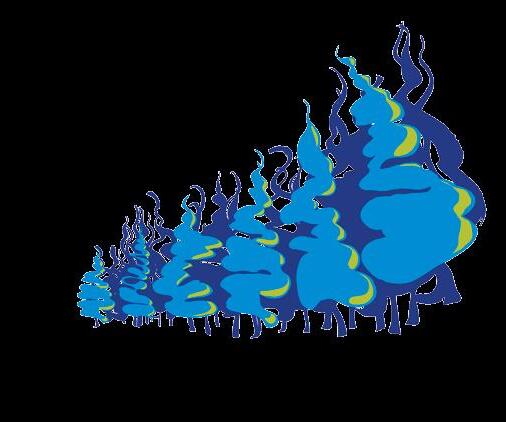
Arthur C. Clarke pointed out “any sufficiently advanced technology is indistinguishable from magic” and the bicycle is that sufficiently advanced technology, an alchemy so simple it barely reveals itself, quietly transporting us to a different relationship with the world around us. It too is going through a process of rediscovery as if it was something we didn’t even know we’d lost. It is the psychedelic of the tattooed bike crank and the trouser-clipped Brompton commuter. Maybe not as instant, maybe not as immediately profound, but taking us there by degrees.
Aldous Huxley, author of mescaline-inspired Doors of Perception and Brave New World , asked on his deathbed to be injected with LSD. “LSD-try itintramuscular-100mmg”
Albert Hoffman in his last interview said “I don’t need LSD to die; I can face death with joy…the beauty of creation is the best drug in the world.”
High on endorphins after a good ride through overgrown lanes I can agree. Not because I’m hippy or hip but because it’s true. And when I recall those roads now they come as a pattern of images and sounds, turning and revolving.
Leaf spin circles tree fire bell yellow hand judder soil taste
sing spoke chatter garlic white pool of pupil tarmac
bird cough ing blink into million million million rain.
“I didn’t come here for Zen diagrams and hippy platitudes, I just want to ride my bike.”
97
“I didn’t come here for Zen diagrams and hippy platitudes, I just want to ride my bike.”
 Illustration by Eleanor Shakespeare / eleanorshakespeare.com
Illustration by Eleanor Shakespeare / eleanorshakespeare.com
If you wish to make your mark in the next issue of boneshaker or simply want to recommend people or projects that you think we should feature, then please do get in touch:
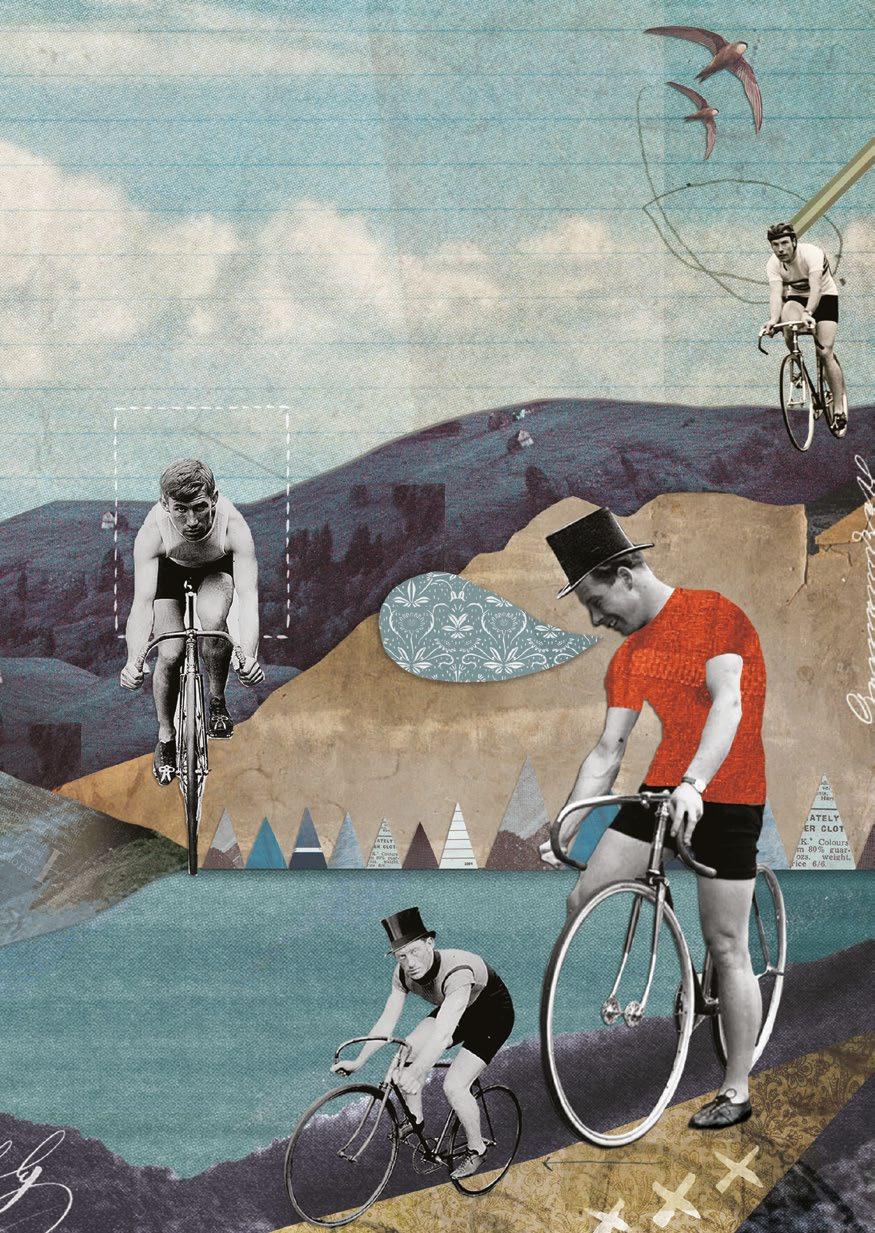
web boneshakermag.com
email boneshakermag@gmail.com
twitter @boneshakermag
facebook facebook.com/boneshakermag
The world is our great book of beauty and romance, and on your cycle you can gradually master it, chapter by chapter, volume by volume.
ELIZABETH ROBBINS PENNELL, 1890









 Illustrations by Samuel James Hunt
Illustrations by Samuel James Hunt
















 Images
Words
by Colin Tonks
by Zoe Howes-Wiles
Images
Words
by Colin Tonks
by Zoe Howes-Wiles






 Words: Max Lehmann & Tony Haupt Photos: Tony Haupt / tonyhauptphoto.de
Words: Max Lehmann & Tony Haupt Photos: Tony Haupt / tonyhauptphoto.de









 Photos by Joff Summerfield / calloftheroad.co.uk
Words by Marc Simper-Allen
Photos by Joff Summerfield / calloftheroad.co.uk
Words by Marc Simper-Allen


































 INTERVIEW BY MATT COOK / HELLOMATTCOOK.COM
INTERVIEW BY MATT COOK / HELLOMATTCOOK.COM
 PHOTOS BY DUNCAN ELLIOTT / DUNCANELLIOTT.NET
PHOTOS BY DUNCAN ELLIOTT / DUNCANELLIOTT.NET






























 Images courtesy of The Historic New Orleans Collection, acc. no. 98-62-L.
Images courtesy of The Historic New Orleans Collection, acc. no. 98-62-L.






















 Photography by Chris Lanaway christoperlanaway.4ormat.com
frame
Photography by Chris Lanaway christoperlanaway.4ormat.com
frame











 Illustration by Eleanor Shakespeare / eleanorshakespeare.com
Illustration by Eleanor Shakespeare / eleanorshakespeare.com

